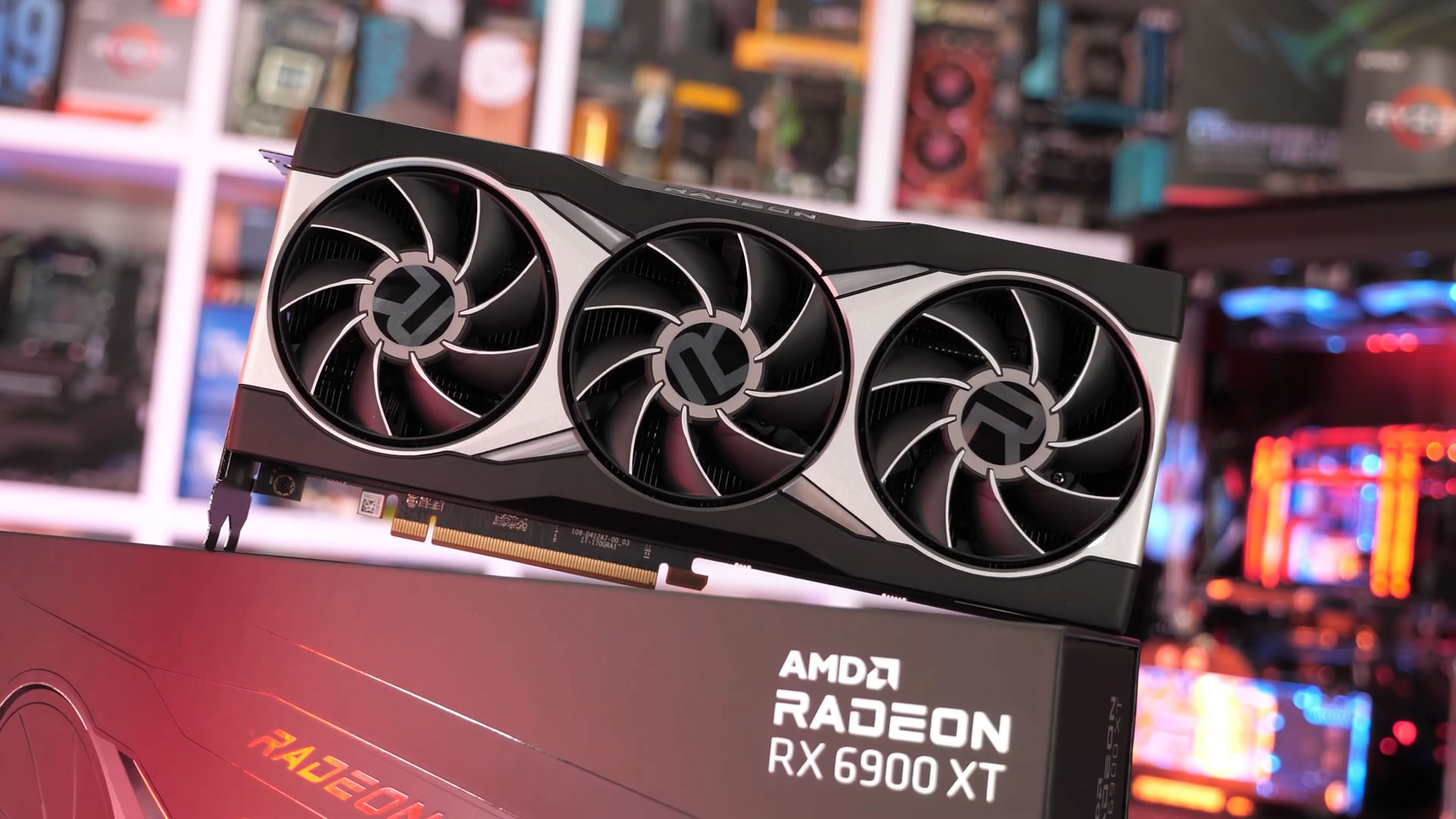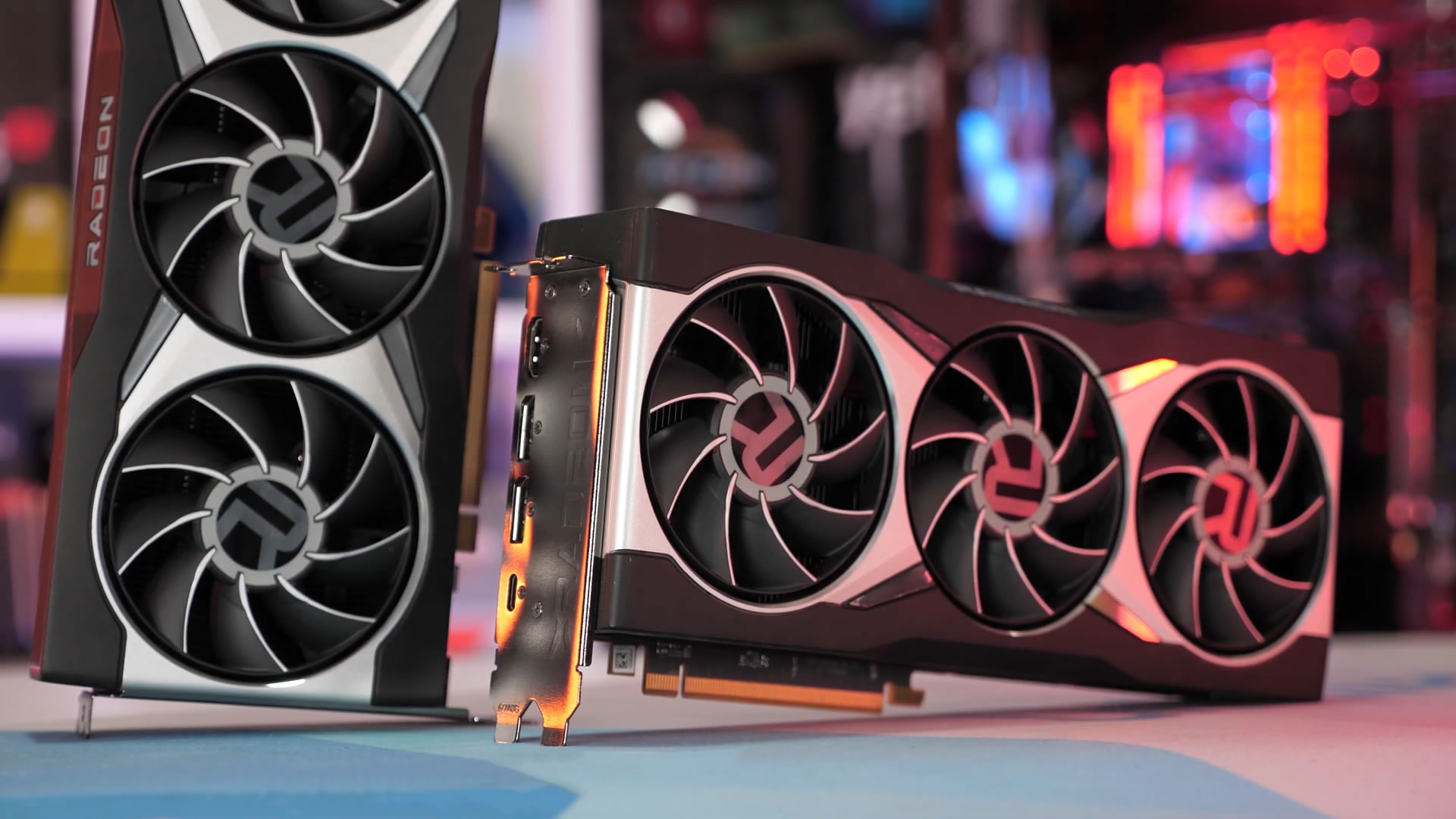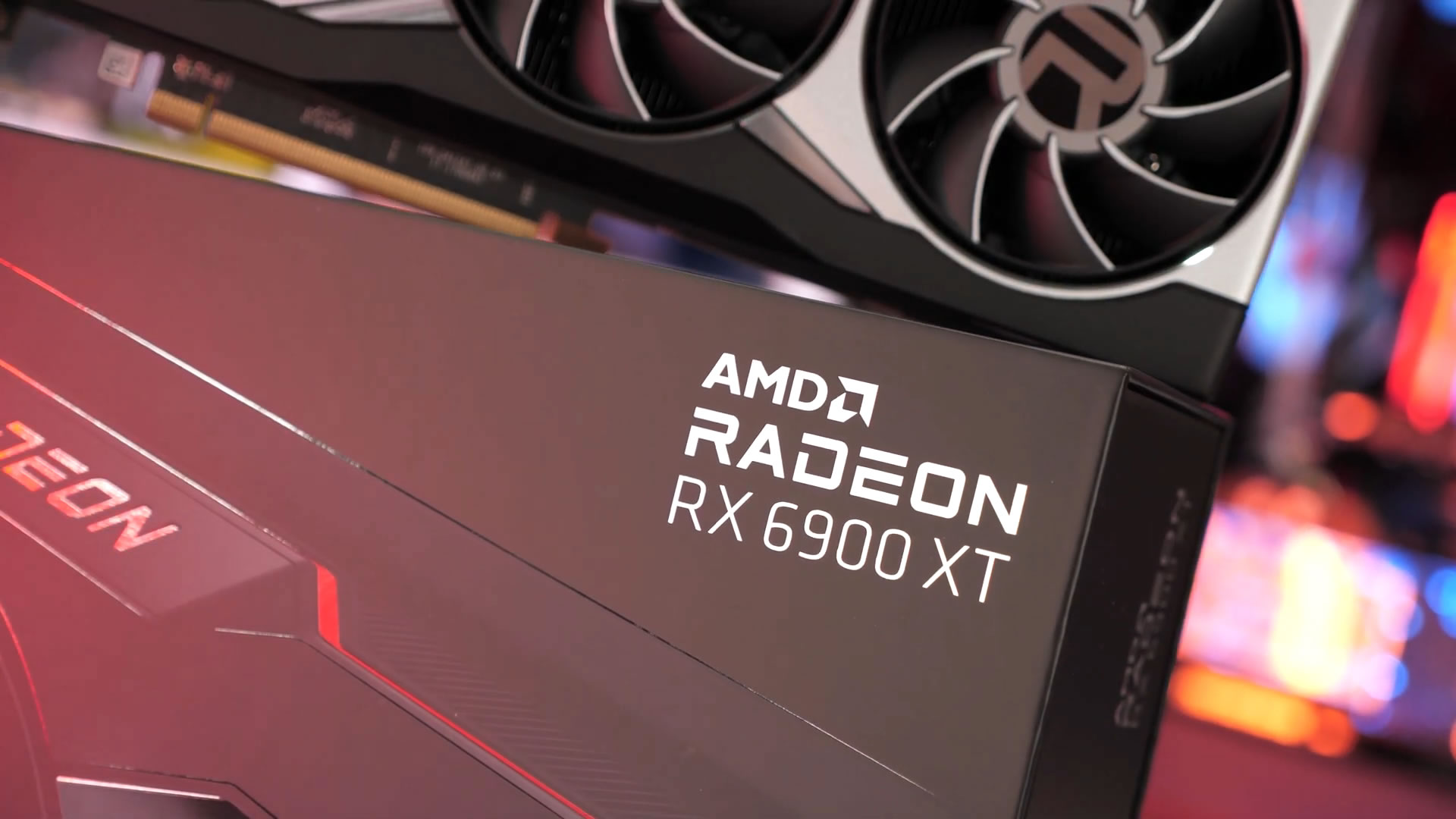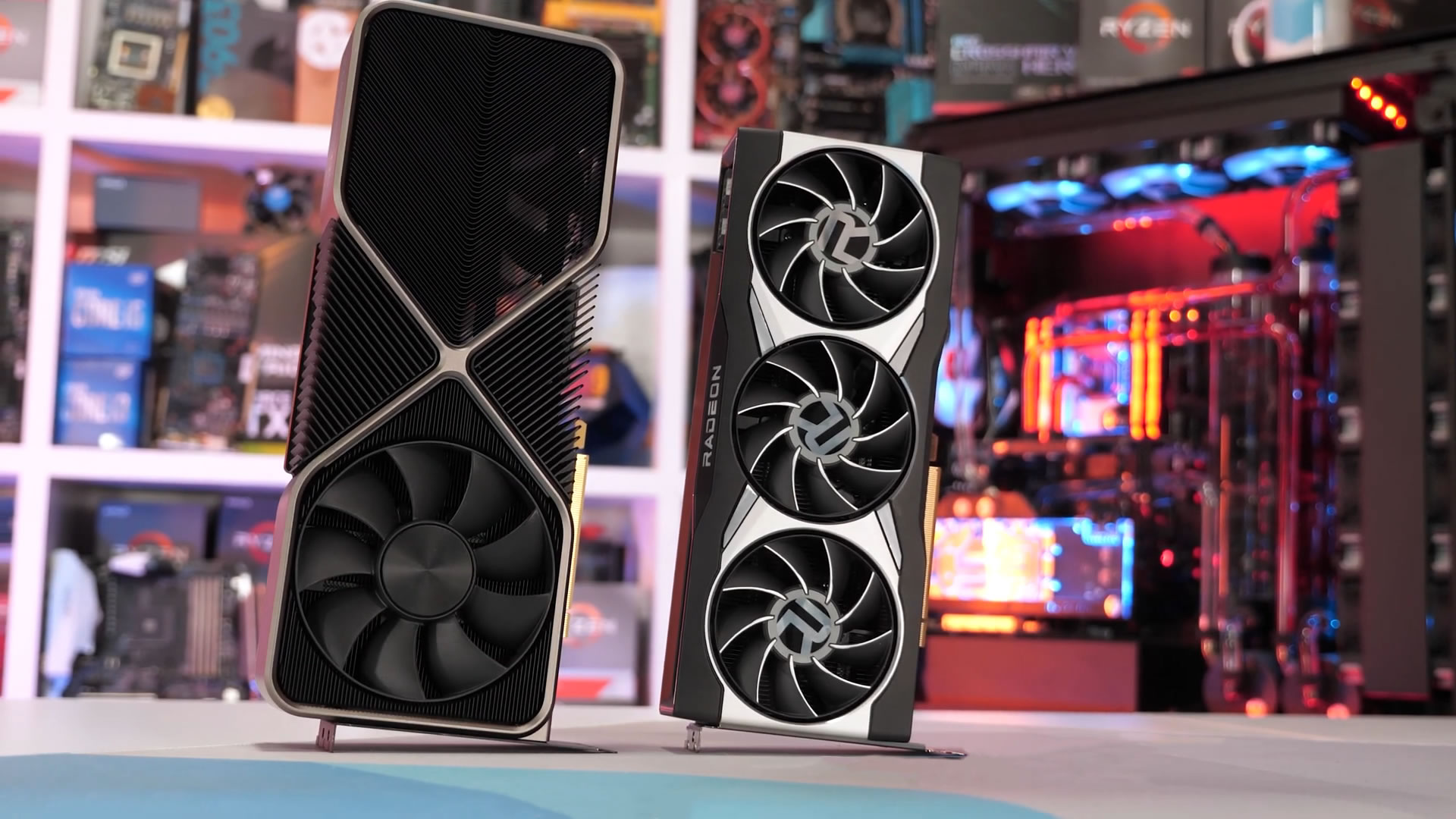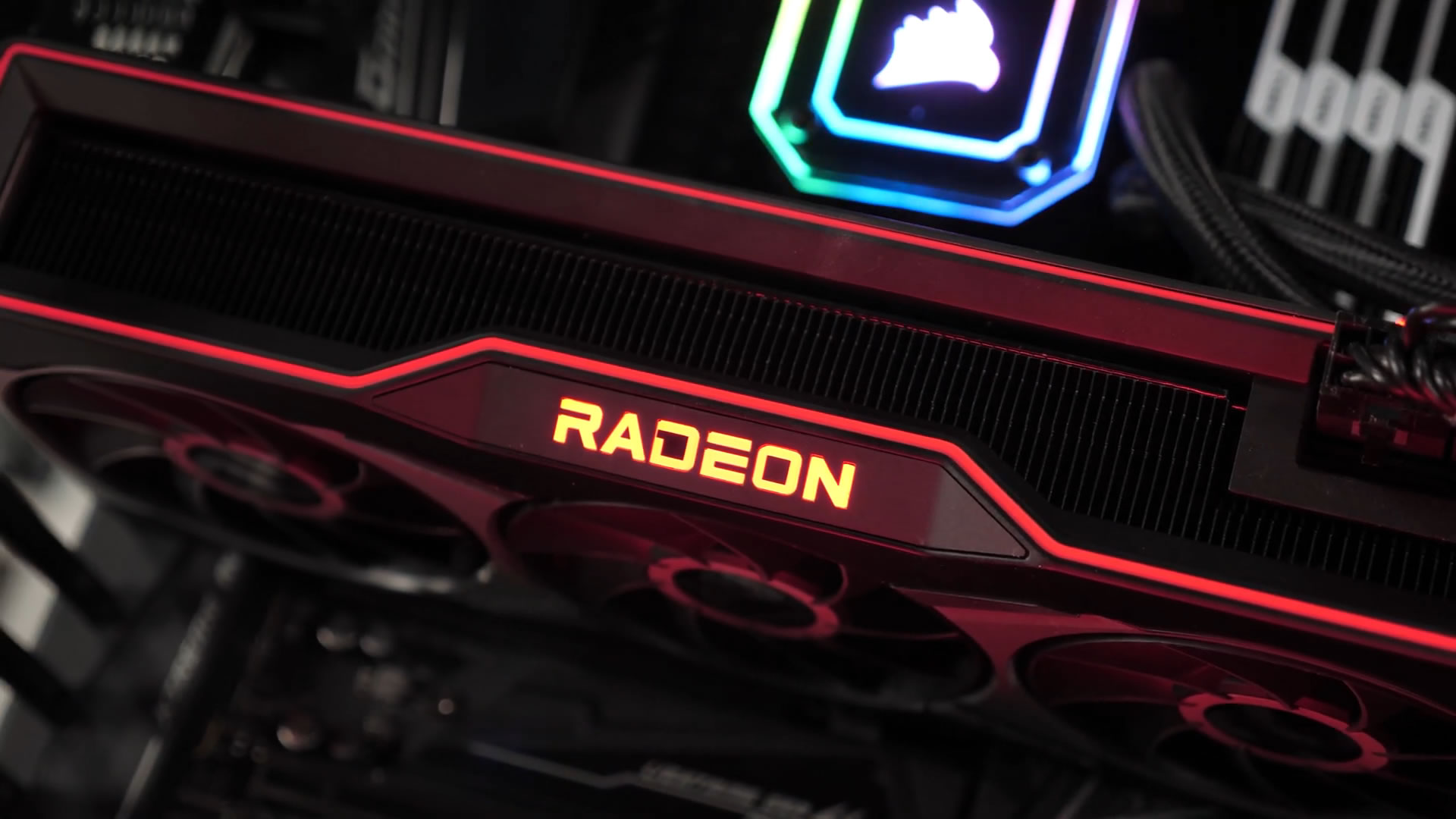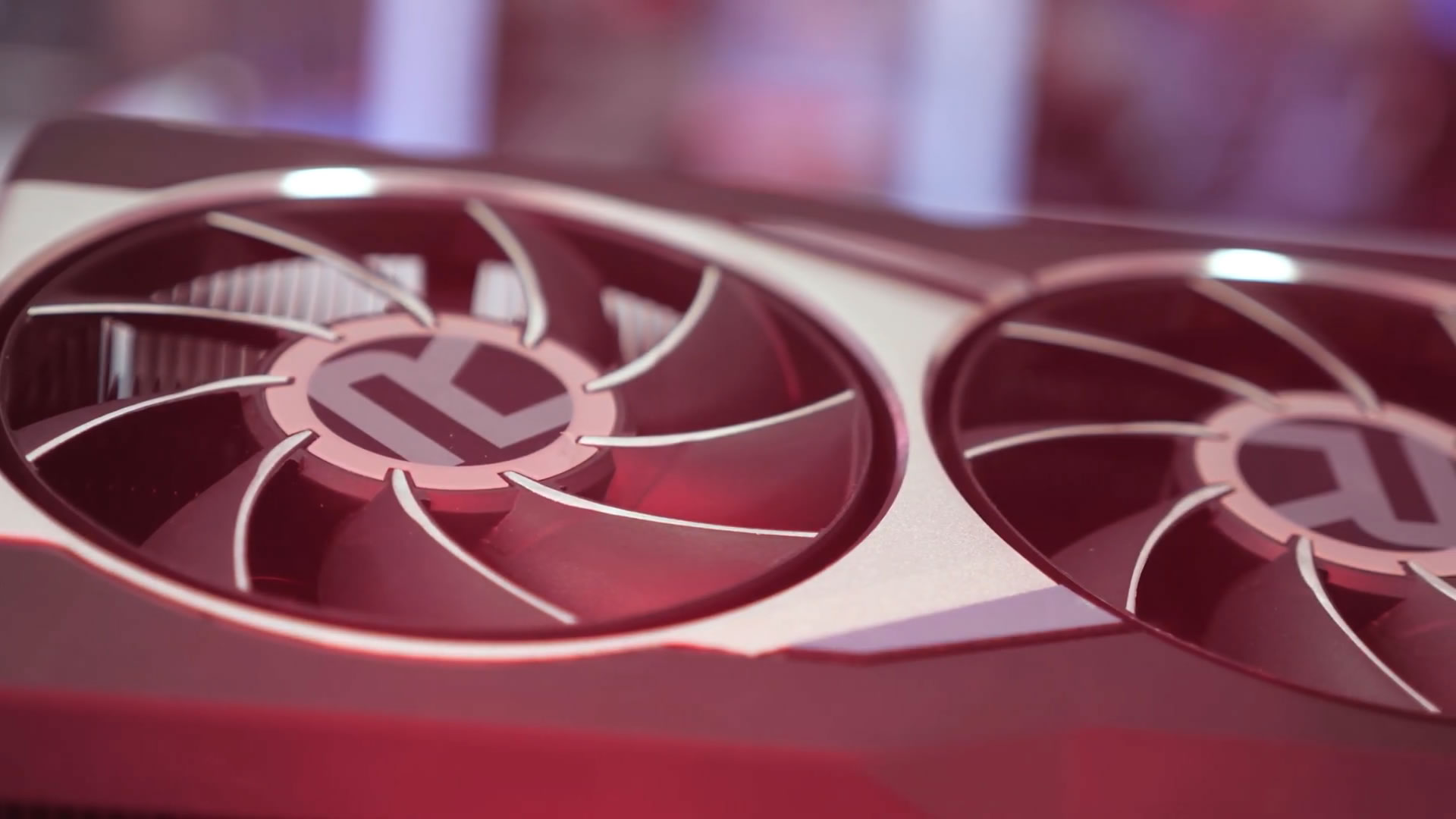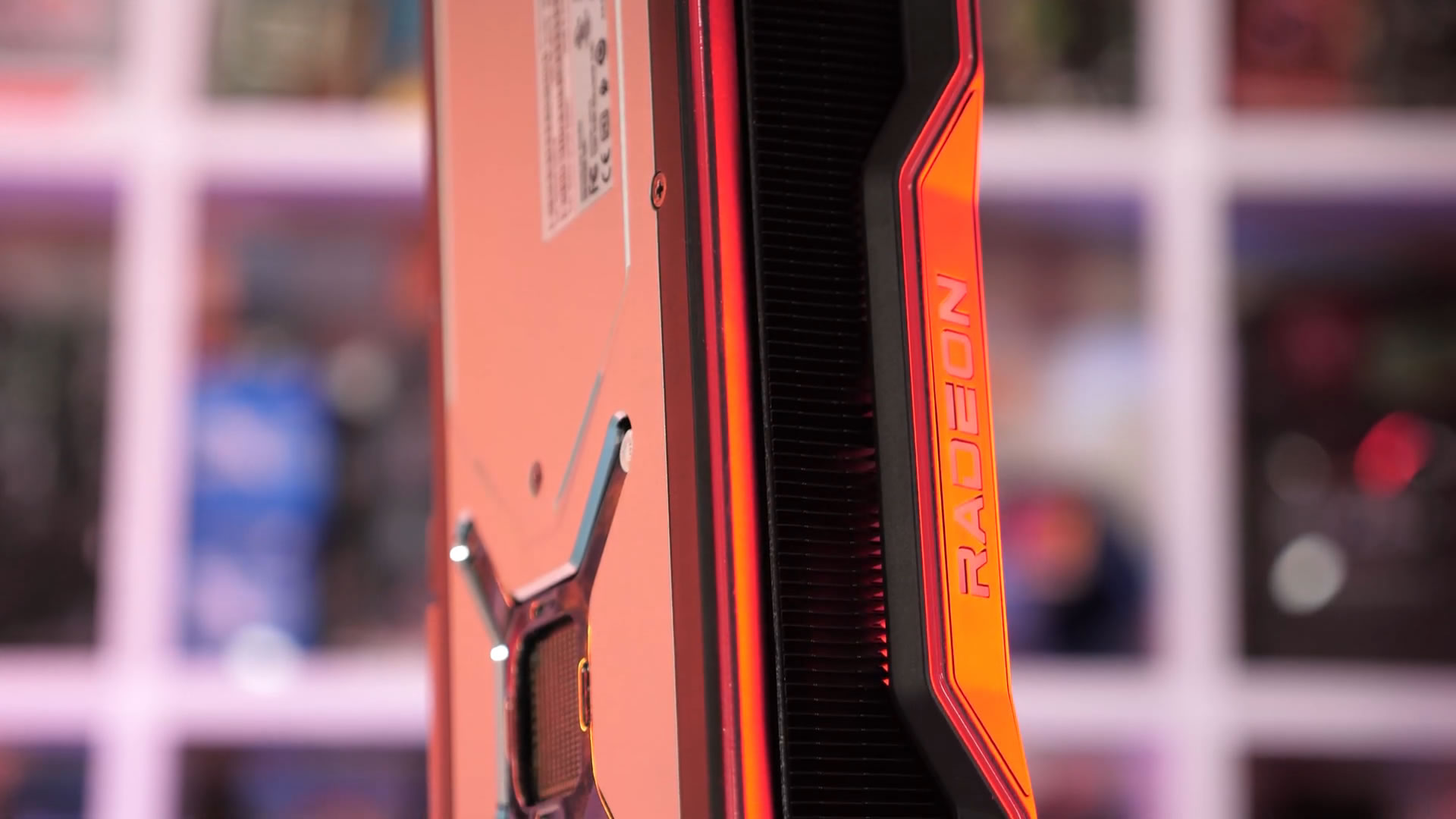The RX 6900 XT is AMD's most expensive Radeon product ever to feature a single GPU at $1,000. We had seen extravagant Radeon GPUs that broke that thousand dollar barrier in previous generations, but those always carried dual GPUs such as the $1,000 Radeon HD 7990 or the insane $1,500 Radeon R9 295X2, though neither of those were great as they relied heavily on Crossfire driver and game support.
The Radeon RX 6900 XT doesn't suffer from those issues, packing a single GPU with 5120 cores. However, that doesn't mean it's any better in terms of value. When compared to the 6800 XT we're getting just 11% more cores and TMUs with the same 128 ROPs. The cores clock up to the same 2250 MHz and because the memory subsystem goes unchanged, we're still looking at 16GB of GDDR6 16Gbps memory on a 256-bit wide memory bus for a peak bandwidth of 512GB/s.
On paper, the RX 6900 XT is set to be no more than 11% faster than the 6800 XT while costing over 50% more, at least according to the suggested retail price. That's all you need to know about the 6900 XT, but of course, we'll put it to the test, because that's kind of what we do here.
For the sake of practicality, we won't make this an overly long review. Just like we did when reviewing the GeForce RTX 3090, we'll look at a number of games and jump into 18 game average graphs, followed by cost per frame and all that good stuff.
| GeForce RTX 3090 |
GeForce RTX 3080 |
Radeon RX 6900 XT |
Radeon RX 6800 XT |
Radeon RX 6800 |
|
|---|---|---|---|---|---|
| Price (MSRP) | $1500 | $700 | $1000 | $650 | $580 |
| Release Date | Sept. 2020 | Dec. 2020 | Nov. 2020 | ||
| Process | Samsung 8N | TSMC N7 | |||
| Transistors (billion) | 28.3 | 26.8 | |||
| Die Size (mm2) | 628.4 | 519 | |||
| Core Config | 10496 / 328 / 112 | 8704 / 272 / 96 | 5120 / 320 / 128 | 4608 / 288 / 128 | 3840 / 240 / 96 |
| Core Clock Frequency | 1400 / 1700 MHz | 1440 / 1710 MHz | 2015 / 2250 MHz | 2015 / 2250 MHz | 1815 / 2105 MHz |
| Memory Capacity | 24 GB | 10 GB | 16GB | ||
| Memory Speed | 19.5 Gbps | 19 Gbps | 16 Gbps | ||
| Memory Type | GDDR6X | GDDR6 | |||
| Bus Type / Bandwidth | 384-bit / 935.8 GB/s | 320-bit / 760 GB/s | 256-bit / 512 GB/s | ||
| TGP | 320 watt | 300 watt | 250 watt | ||
It's worth mentioning the RTX 3090 as the 6900 XT wouldn't exist without it. We're sure you've noticed over the years how mainstream video gaming has become, if you're under the age of 30 and don't play video games, you're now considered an outlier. As gaming grew in popularity, PC hardware demand surged, and while some people assume that increased demand means mass production and therefore lower prices, that isn't always the case.
With limited competition and increased difficulty to achieve performance gains, pricing of graphics cards has only continued to climb. Products like the RTX 3080 and 6800 XT are likely quite reasonably priced, but why limit yourself to reasonably priced graphics cards when there's a market for more exotic, over the top products, like the $1,500 RTX 3090?
Nvidia has been testing the waters with flagship GPUs priced well over $1,000 for years now and have discovered there are those willing to spend big dollars just to have the best, even if it's best by a very small margin. In the case of the RTX 3090, they decided to offer a gaming graphics card that's less than 20% faster than their next best offering, while charging over twice as much.
AMD has followed suit and created the RX 6900 XT, allowing them to cash in on gamers with more money than sense. The premium may be less drastic, but you're also getting less gains with no added perks. At least the RTX 3090 offers over twice the VRAM capacity at 24 GB vs. 10GB for the 3080. As we mentioned a moment ago, the 6900 XT shares the same 16GB configuration as the 6800 XT, which makes it less special.
That also means the RX 6900 XT packs 33% less VRAM than the RTX 3090. The fact that it's 33% cheaper might not convince gamers with deep pockets to give AMD a go, but with availability the way it is, we guess most will just go with whatever they can find available.
The test system for this review is powered by the Ryzen 9 3950X with 32GB of DDR4-3200 CL14 memory in a dual-rank, dual-channel configuration on the MSI X570 Unify motherboard. Let's get into the results...
Benchmarks
Starting with Death Stranding at 1440p, we find that the 6900 XT is just 4% faster than the 6800 XT and 3090. We're likely running into a CPU limitation with average frame rates over 160.
Moving to 4K does confirm we were CPU limited with top-end GPUs at 1440p as the 6900 XT now scores 14% faster than the 6800 XT, which is beyond what we were expecting to see. With this, the 6900 XT is able to edge ahead of the RTX 3090 by a mere 3%.
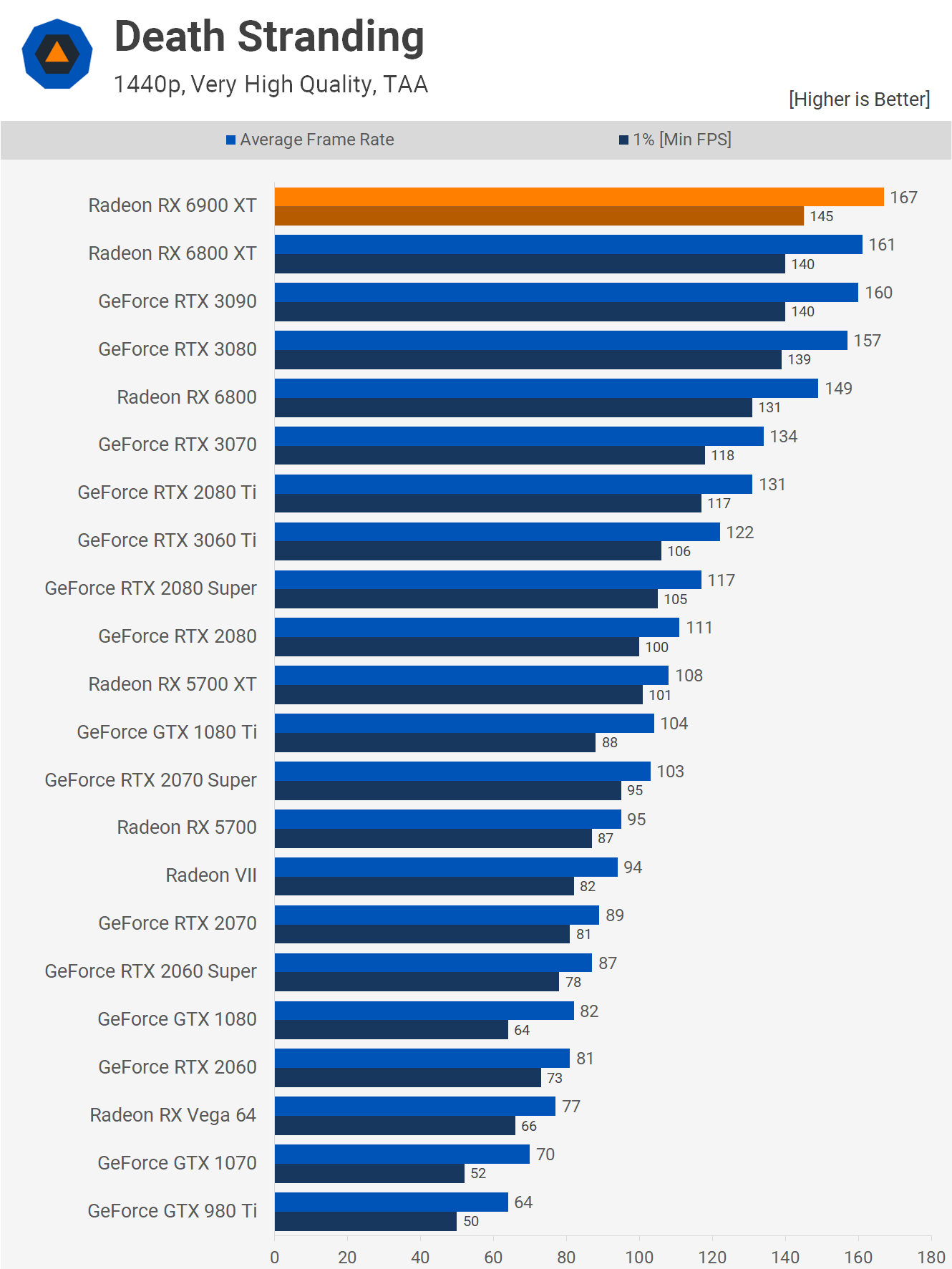
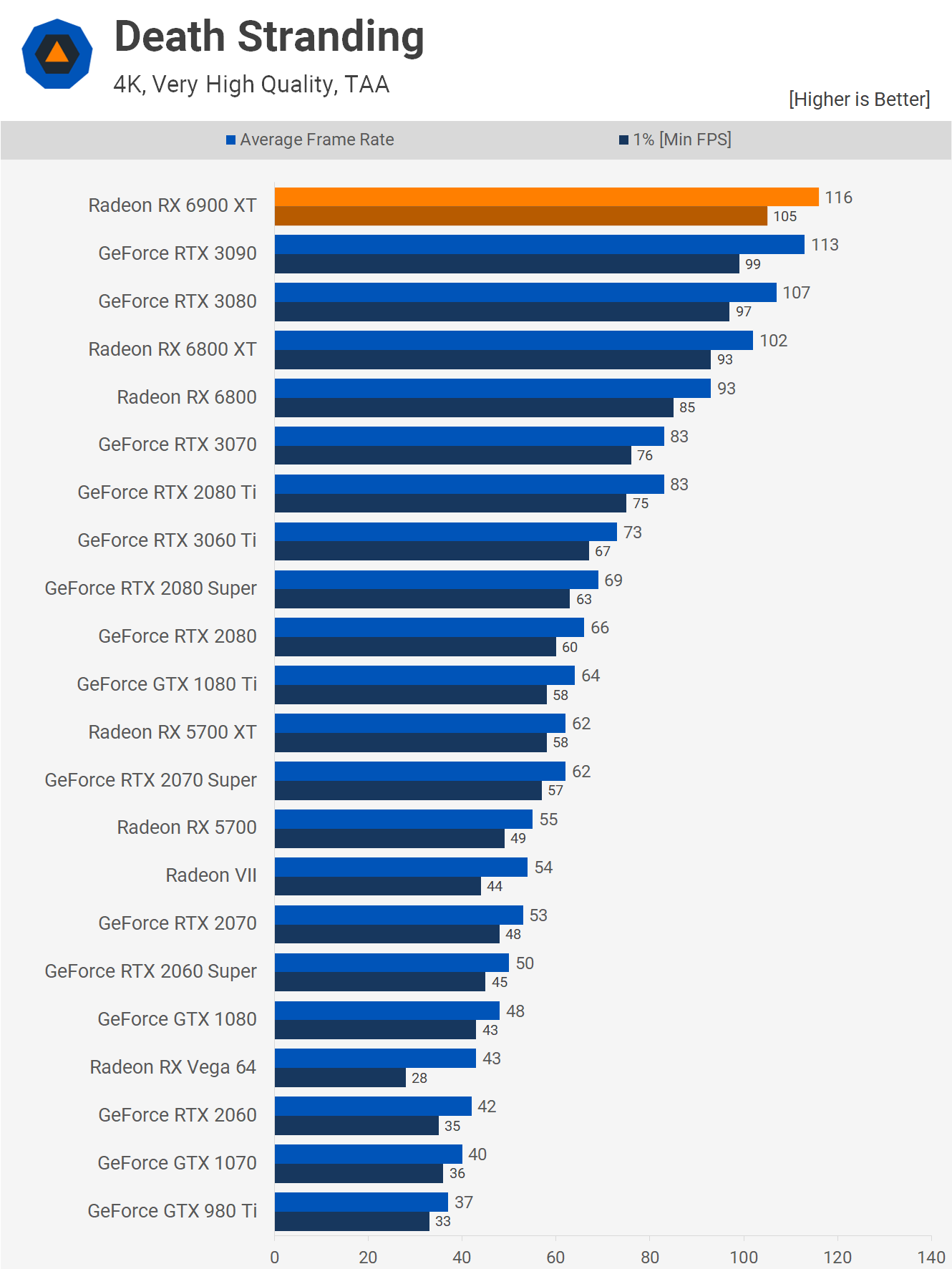
Moving on to Rainbow Six Siege, we see that at 1440p the 6900 XT is 7% faster than the 6800 XT, and that's about what we're expecting to see more of. The margin opens up to 10% at 4K and that puts the 6900 XT ahead of the RTX 3080 but still 8% behind the 3090.


Next we have Watch Dogs Legion and at 1440p the 6900 XT was 11% faster than the 6800 XT, jumping up to 85 fps to 94 fps, nudging it ahead of the RTX 3090.
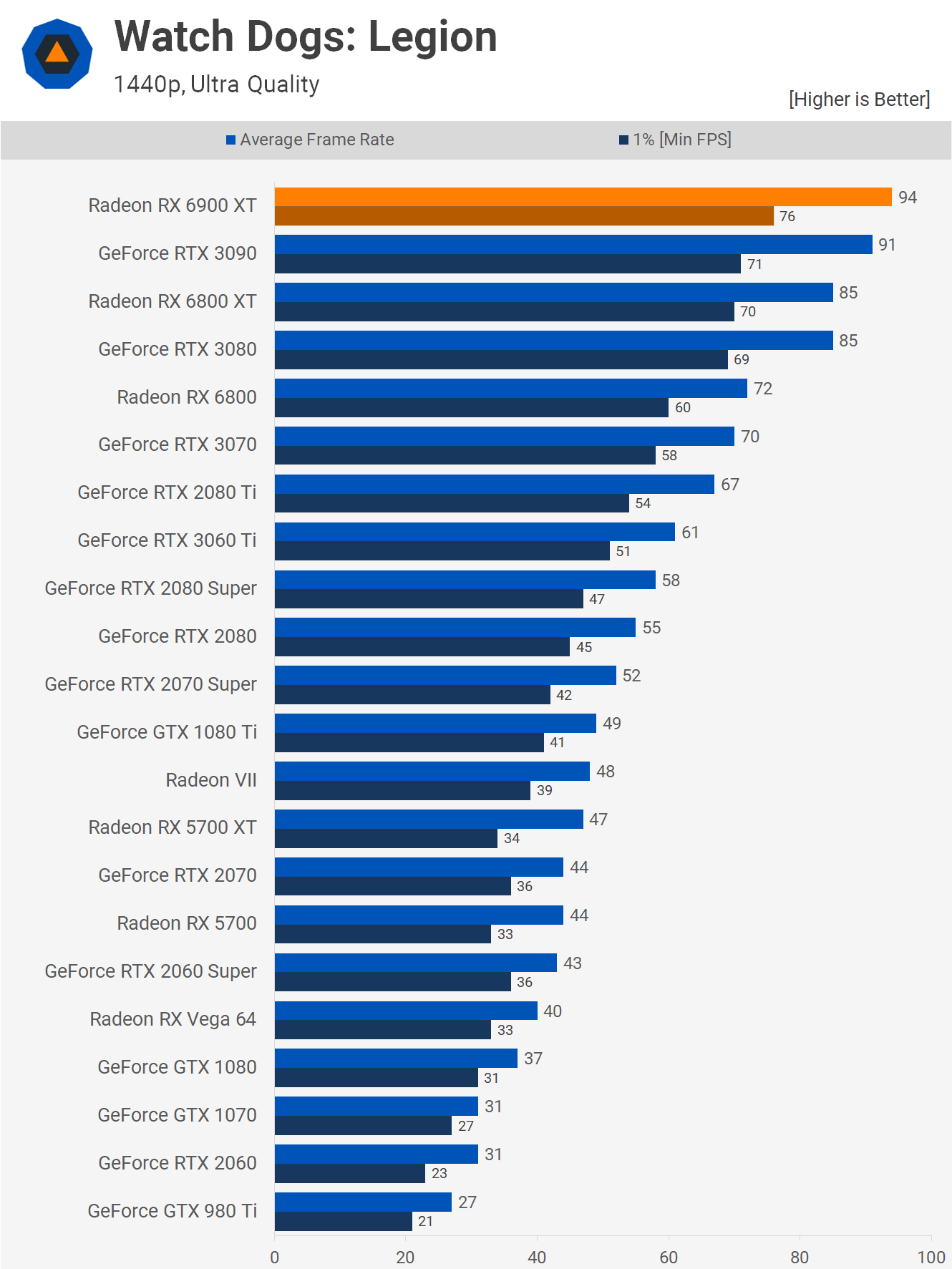
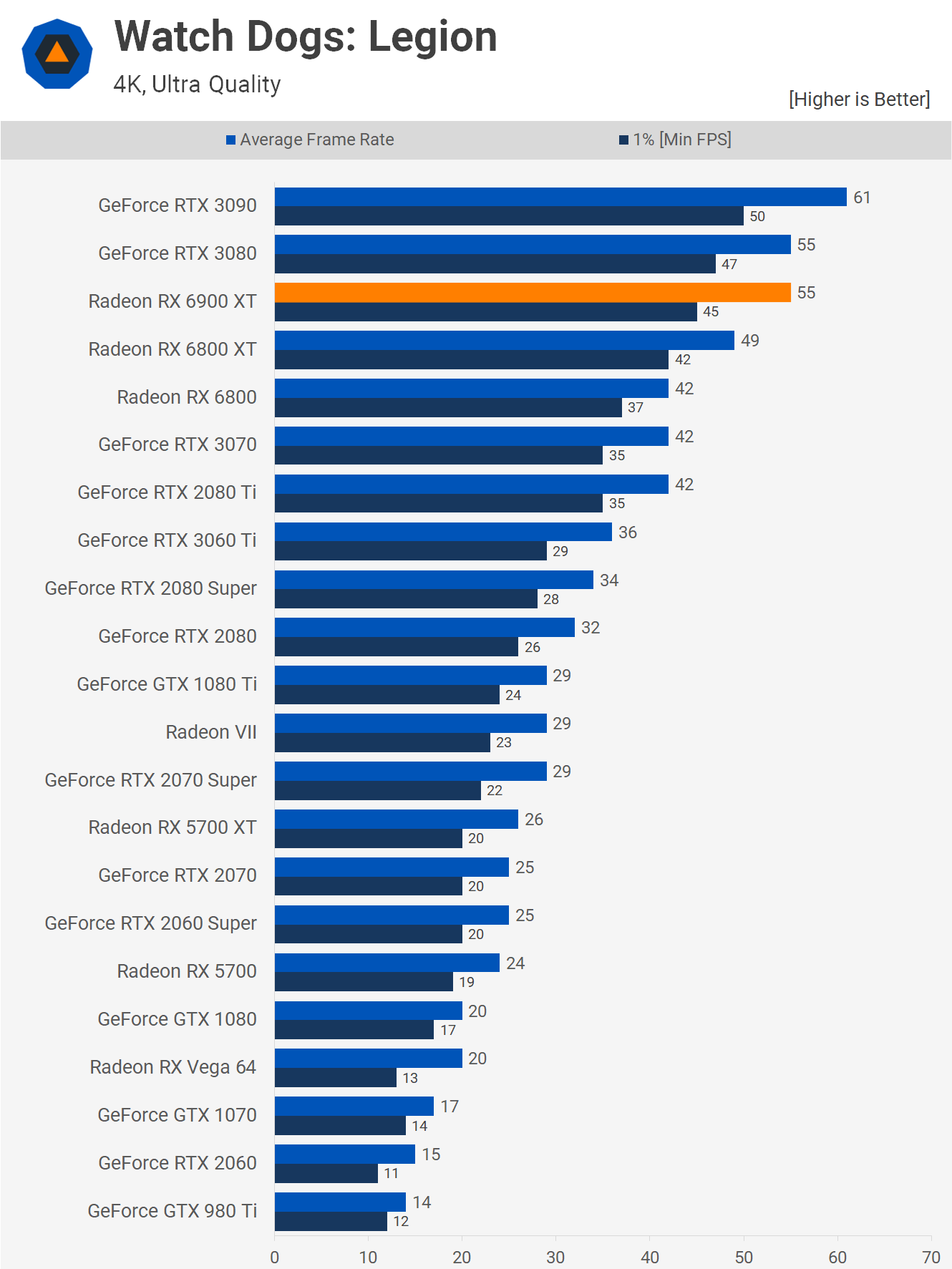
Then at 4K we're looking at a 12% performance increase for the 6900 XT over the 6800 XT, but that meant it was still 10% lower than the 3090.
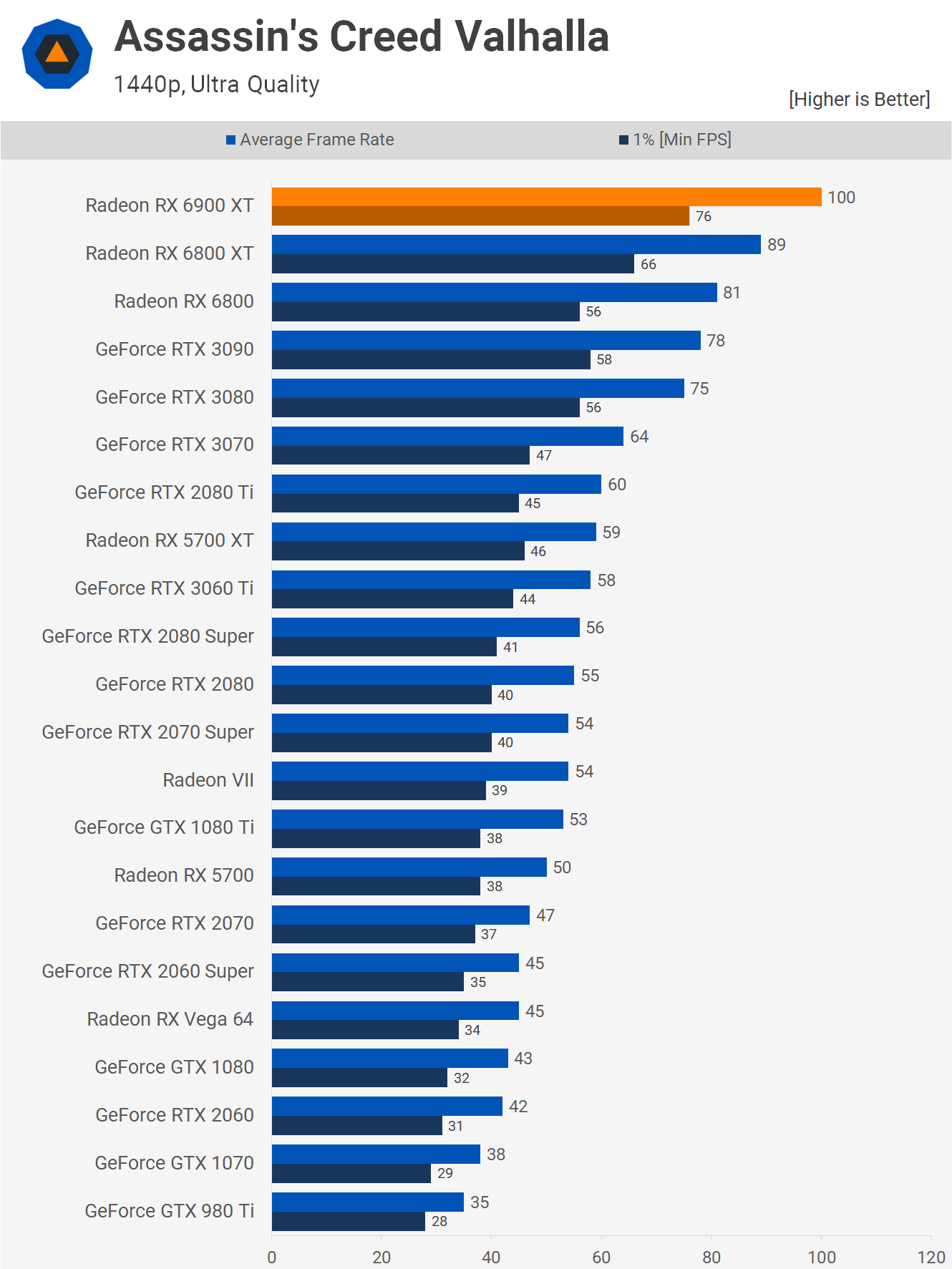

The 6900 XT looks mighty in Assassin's Creed Valhalla, offering a 12% performance increase from the 6800 XT at 1440p to make it 28% faster than the RTX 3090. Keep in mind this is an AMD sponsored title, but still impressive performance.
At 4K, the RTX 3090 comes back quite heavily, though the 6900 XT was able to beat it by an 8% margin with 64 fps on average. That meant it was 12% faster than the 6800 XT.
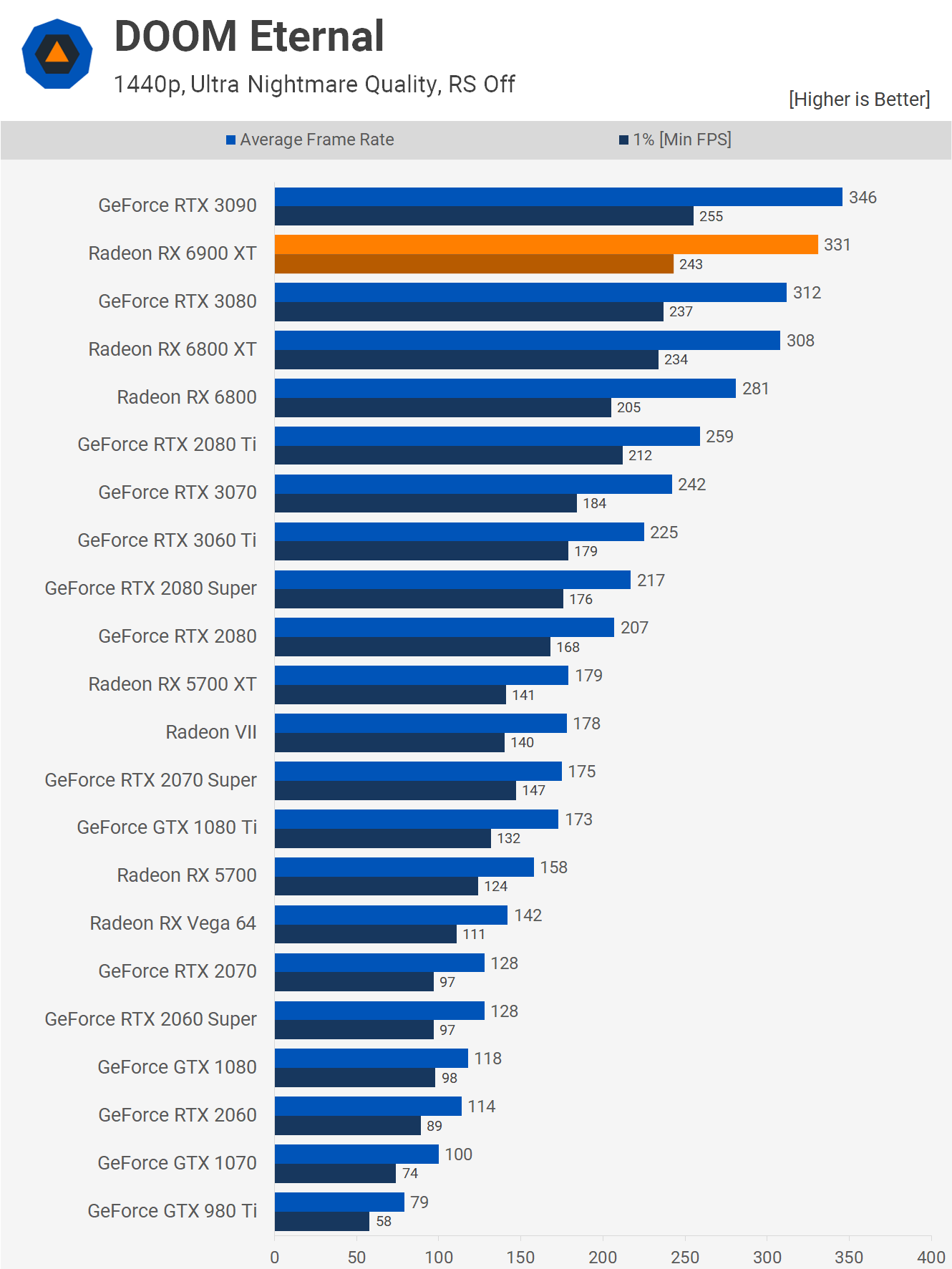
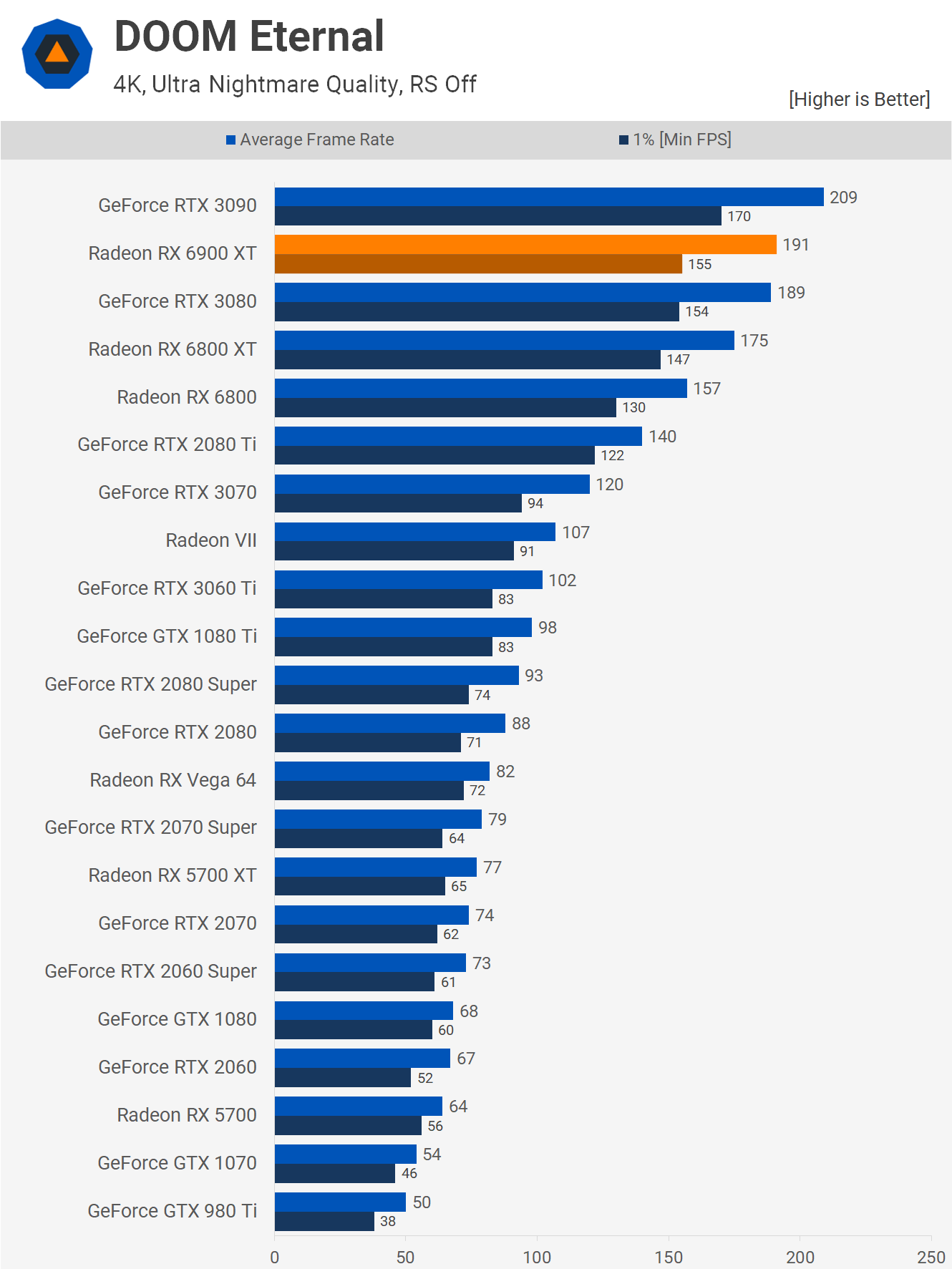
Doom Eternal saw the 6900 XT delivering a 7% performance boost from the 6800 XT at 1440p, though that meant it was still 4% slower than the 3090. The margin to the 3090 grew at 4K as here the 6900 XT was 9% slower, though it was also now 9% faster than the 6800 XT.
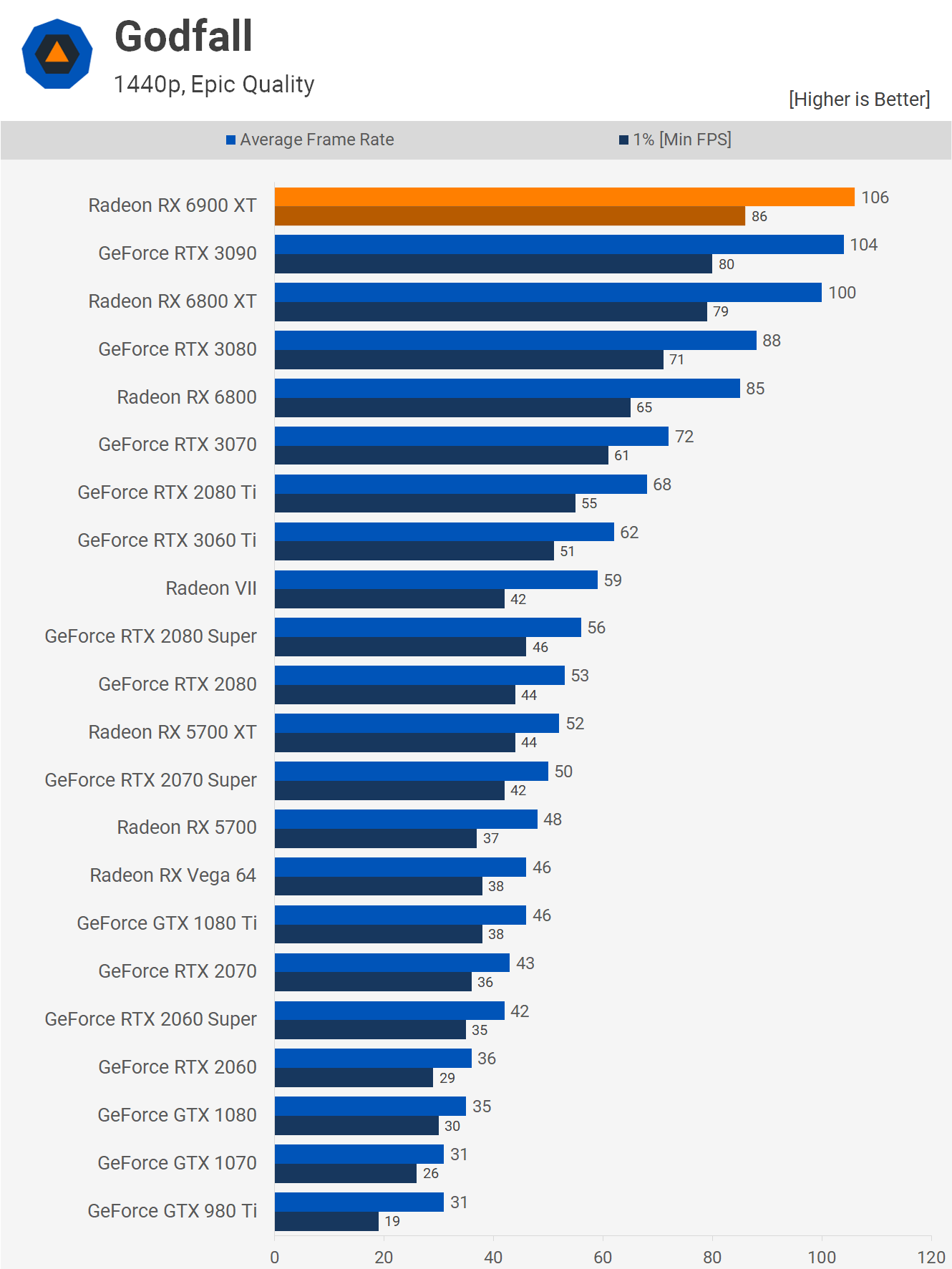
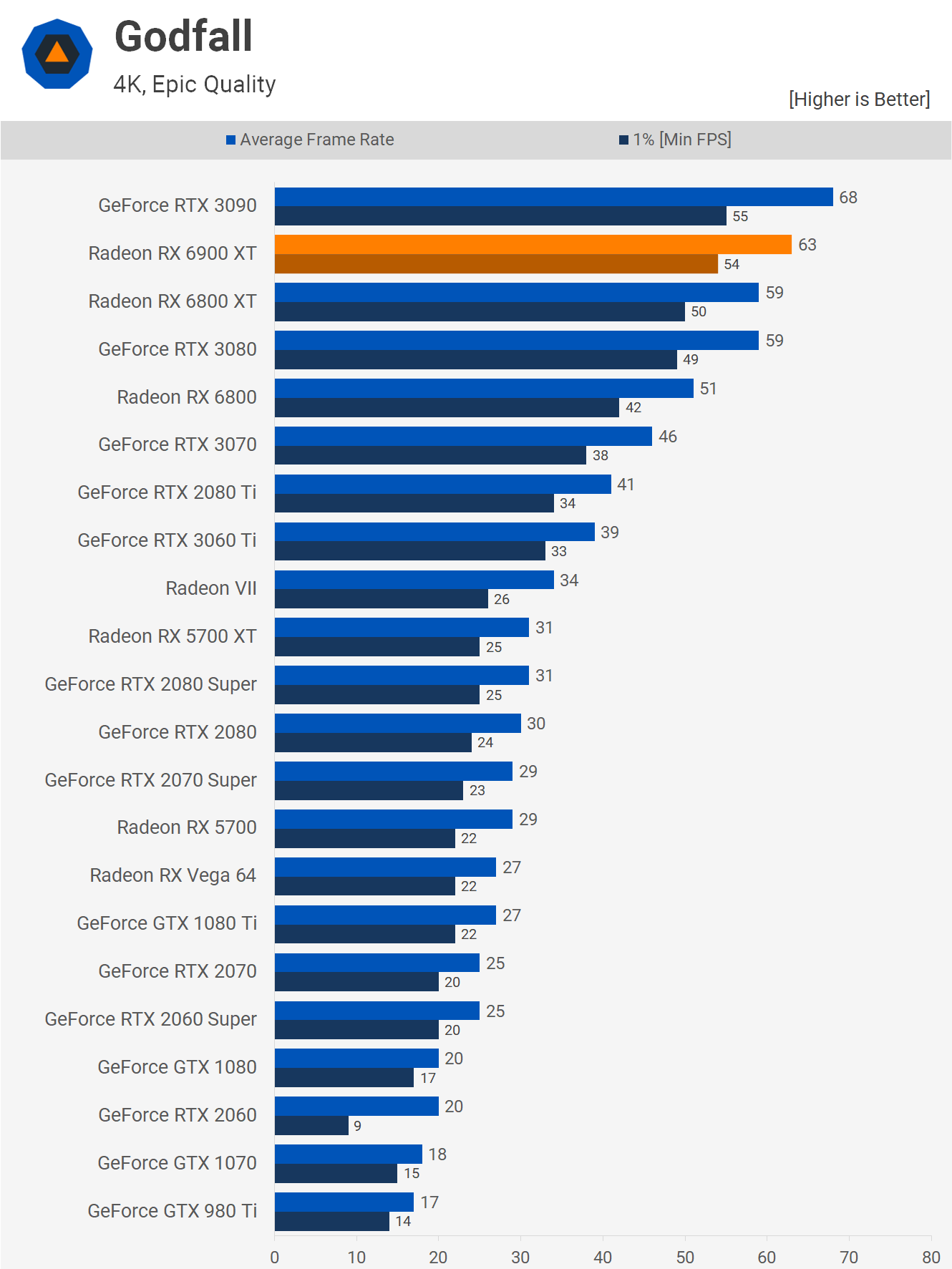
The last game we're going to show individually is Godfall, where the 6900 XT was 6% faster than the 6800 XT and just 2% faster than the 3090 at 1440p.
Then at 4K, the 6900 XT was 8% faster than the 6800 XT which meant it trailed the RTX 3090 by a 7% margin.
Performance Summary
The Radeon RX 6900 XT is up to 12% faster than the 6800 XT and although it only has 11% more cores, we suspect our graphics card sample was maintaining higher clock speeds in those titles when compared to the 6800 XT. Needless to say, 12% is uninspiring for paying over 50% more.
Here's a look at the 18 game average data at 1080p, 1440p and 4K before moving into the power, temps, overclocking and cost per frame graphs. We also plan to look at ray tracing performance...

For those targeting low resolution, high refresh rate gaming the Radeon RX 6900 XT is a better choice than the GeForce RTX 3090, though it's typically not that much better. It's also not much better than the 6800 XT... we're talking about a 5% boost on average.

The 1440p gains are ever so slightly improved. The 6900 XT is on average 8% faster than the 6800 XT and just 2% faster than the 3090.
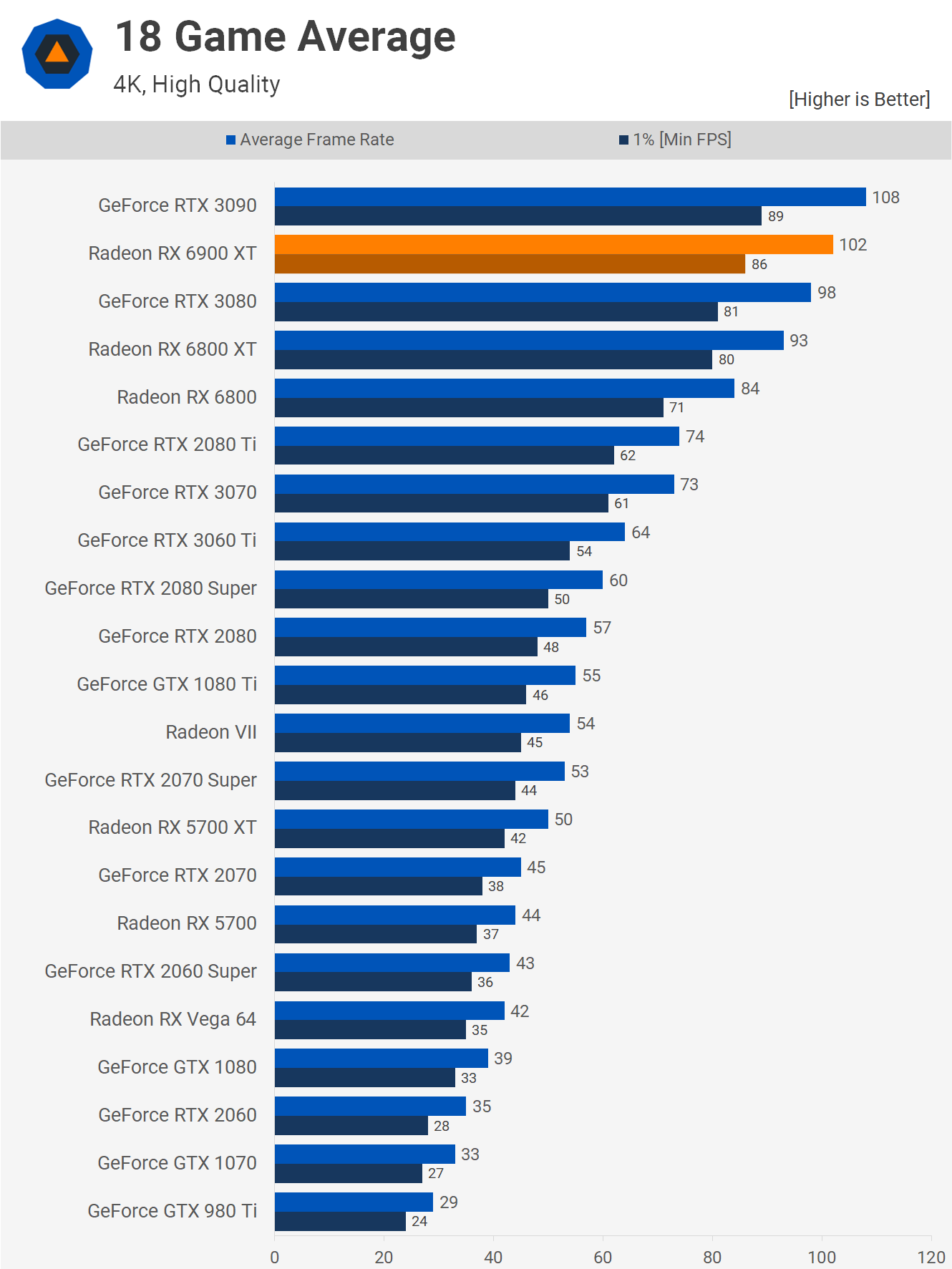
The 6900 XT is on average 10% faster than the 6800 XT at 4K, but also 6% slower than the RTX 3090. Given the performance you're getting from the RTX 3080 and 6800 XT, it's quite clear neither the 6900 XT or RTX 3090 make an ounce of sense.
Ray Tracing Performance
Here's a look at ray tracing performance in Control at 1440p using the medium and high quality setting. We've also tested the RTX 3090 with and without DLSS enabled. We're looking at a 43% reduction in performance for the 6900 XT with medium quality RT enabled while the 3090 sees just a 23% reduction and remains very playable.
Moreover, if we enable DLSS we see no decrease in performance using high quality ray tracing.
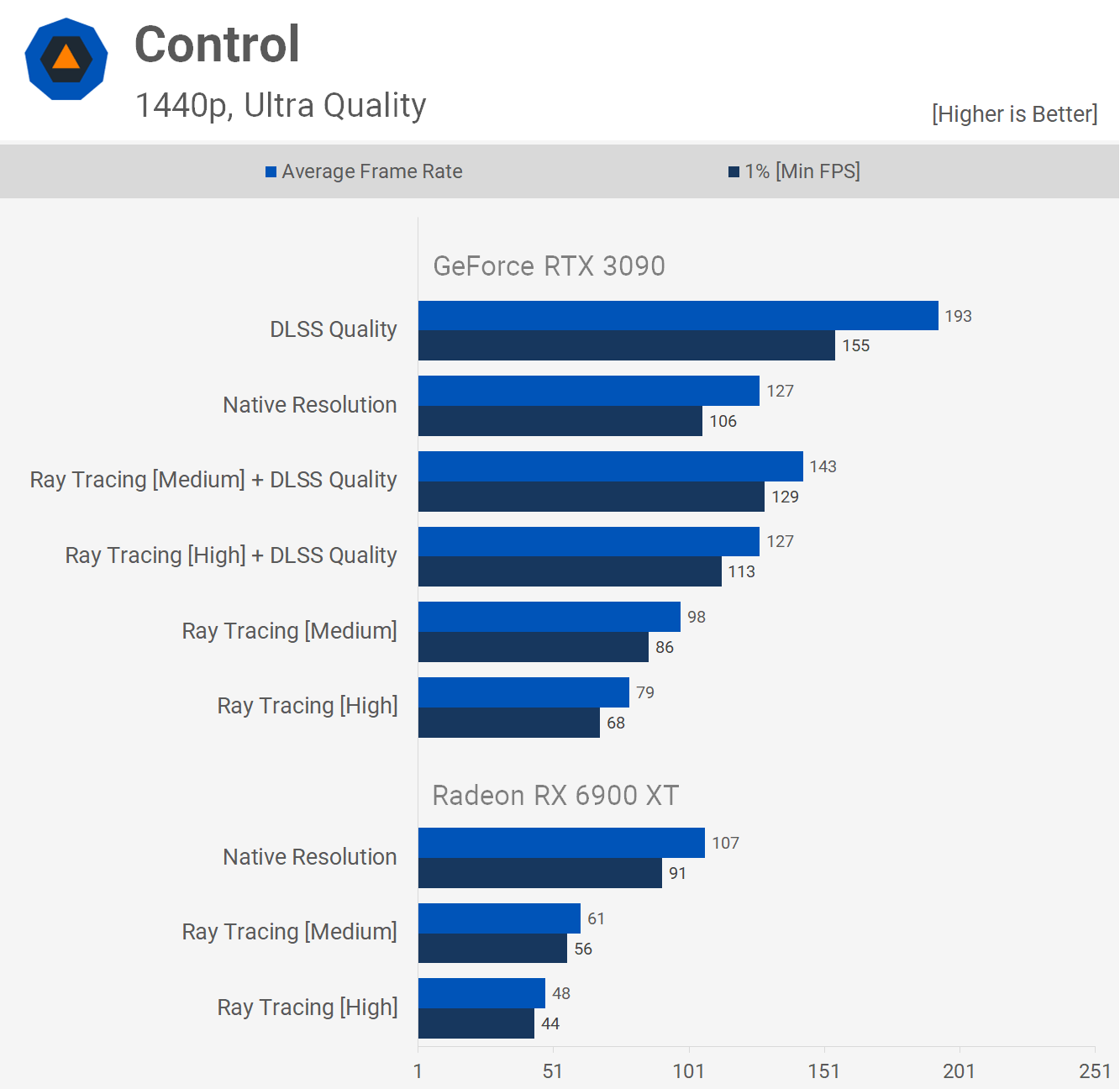
Obviously this game was developed and optimized to take advantage of Nvidia's hardware, so it should come as little surprise that it works much better and this is something we're going to see with all the RTX titles tested.

Another example would be Fortnite which is basically broken with RT enabled on the 6900 XT in terms of performance. The performance hit is pretty disgusting on the RTX 3090 as well, and even DLSS struggles to get us anywhere near native performance. This title becomes visually impressive with RT enabled, but it's not a game you'd necessarily play with this feature turned on given its fast paced action and need for high fps.
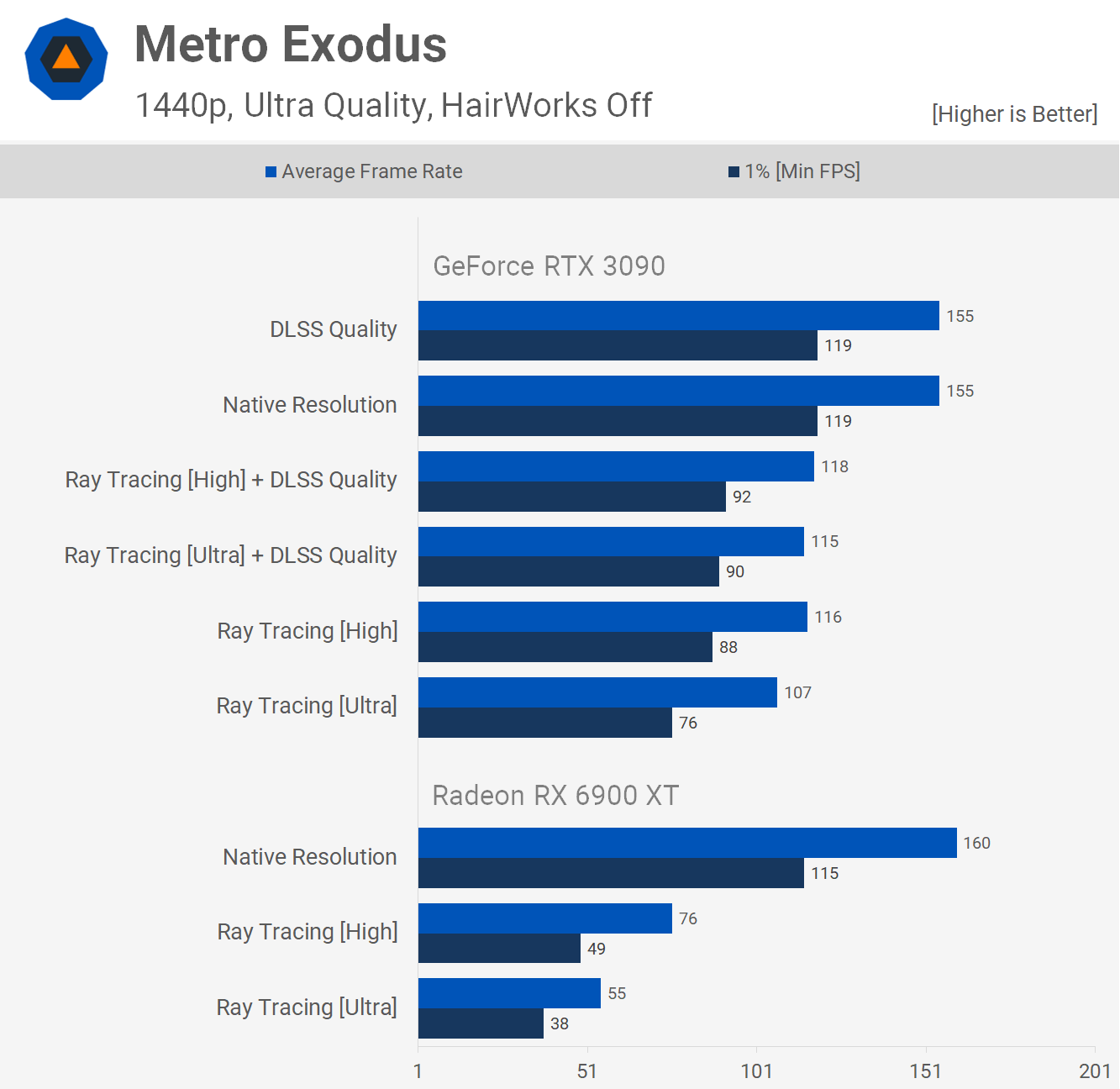
Like Control, Metro Exodus was optimized for Turing, so it plays well with Ampere and not so well with RDNA2's RT support. Here we're looking at a 66% reduction in performance when using ultra quality ray tracing with the 6900 XT, but just a 31% reduction with the RTX 3090.
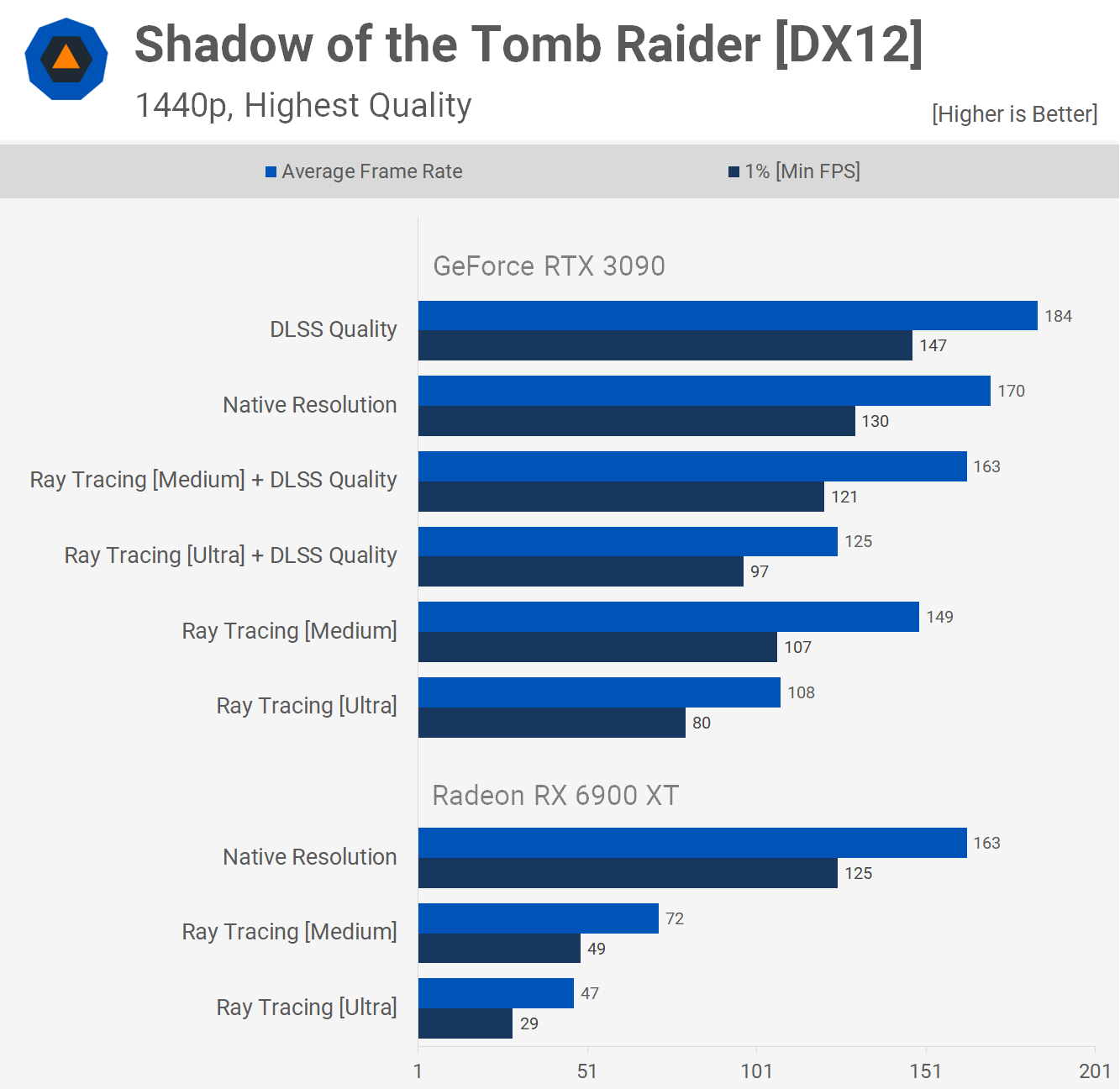
In my opinion ray tracing in Shadow of the Tomb Raider is a complete bust and we struggle to tell when it's enabled. So the 71% hit to frame rates when using ultra ray traced shadows on the 6900 XT is unacceptable and so is the 36% hit seen with the RTX 3090.
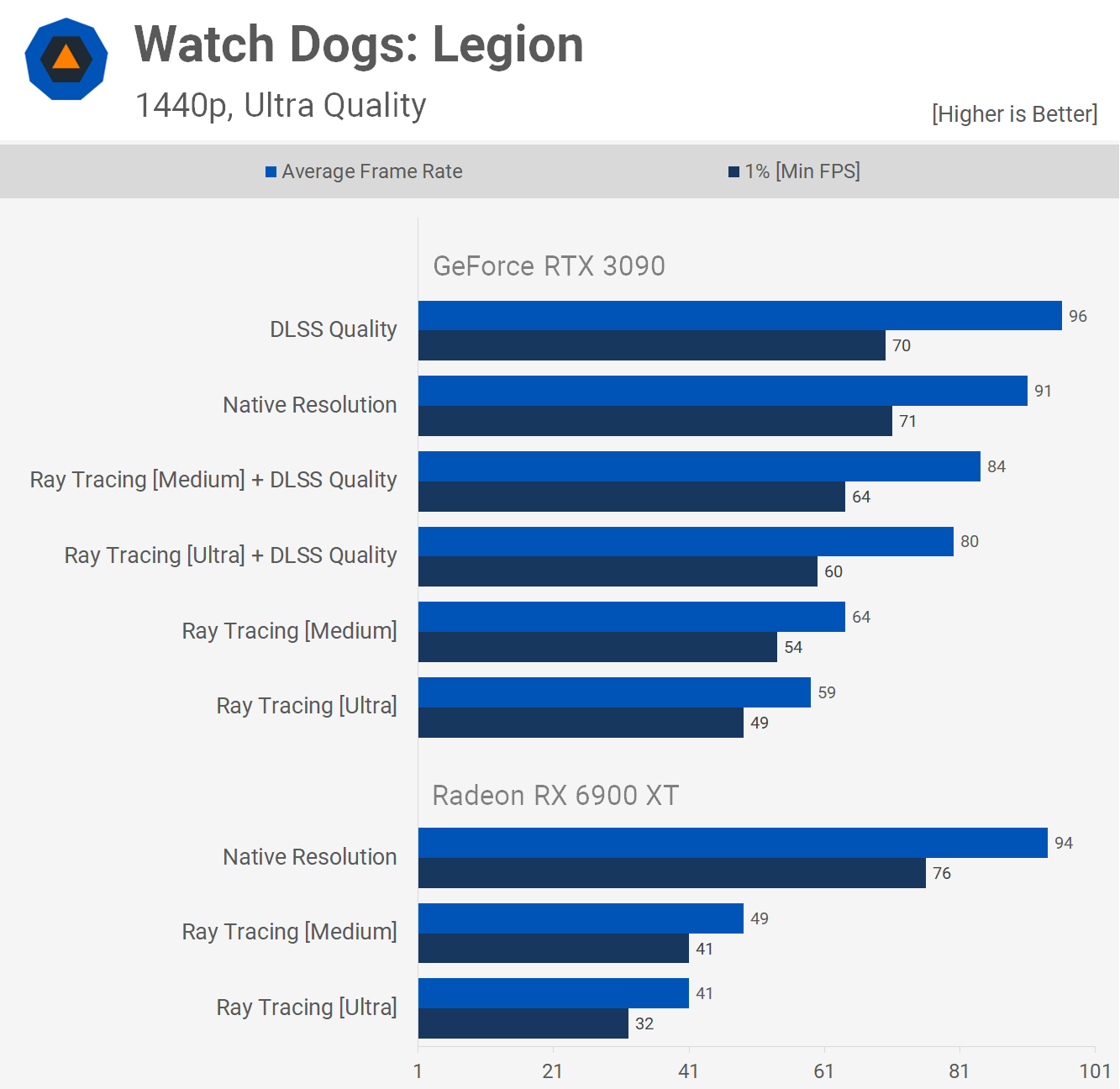
Finally we have Watch Dogs Legion, which is one of two games that actually uses ray traced effects well – the other being Control. The RX 6900 XT faces a 56% performance reduction with ultra ray tracing enabled, whereas the RTX 3090 saw a 35% reduction and then just 12% with DLSS enabled.
Power
Here's a look at total system power consumption and surprisingly the 6900 XT only uses slightly more power than the 6800 XT, presumably we're looking at better quality silicon here.

Using Nvidia's PCAT we also see that the 6900 XT uses slightly more power than the 6800 XT – about a 1% increase in power usage – which may be down to the 6900 XT using higher quality silicon. When compared to the RTX 3090, the 6900 XT consumed 14% less power, though it's also slower in Doom which we use for this test.
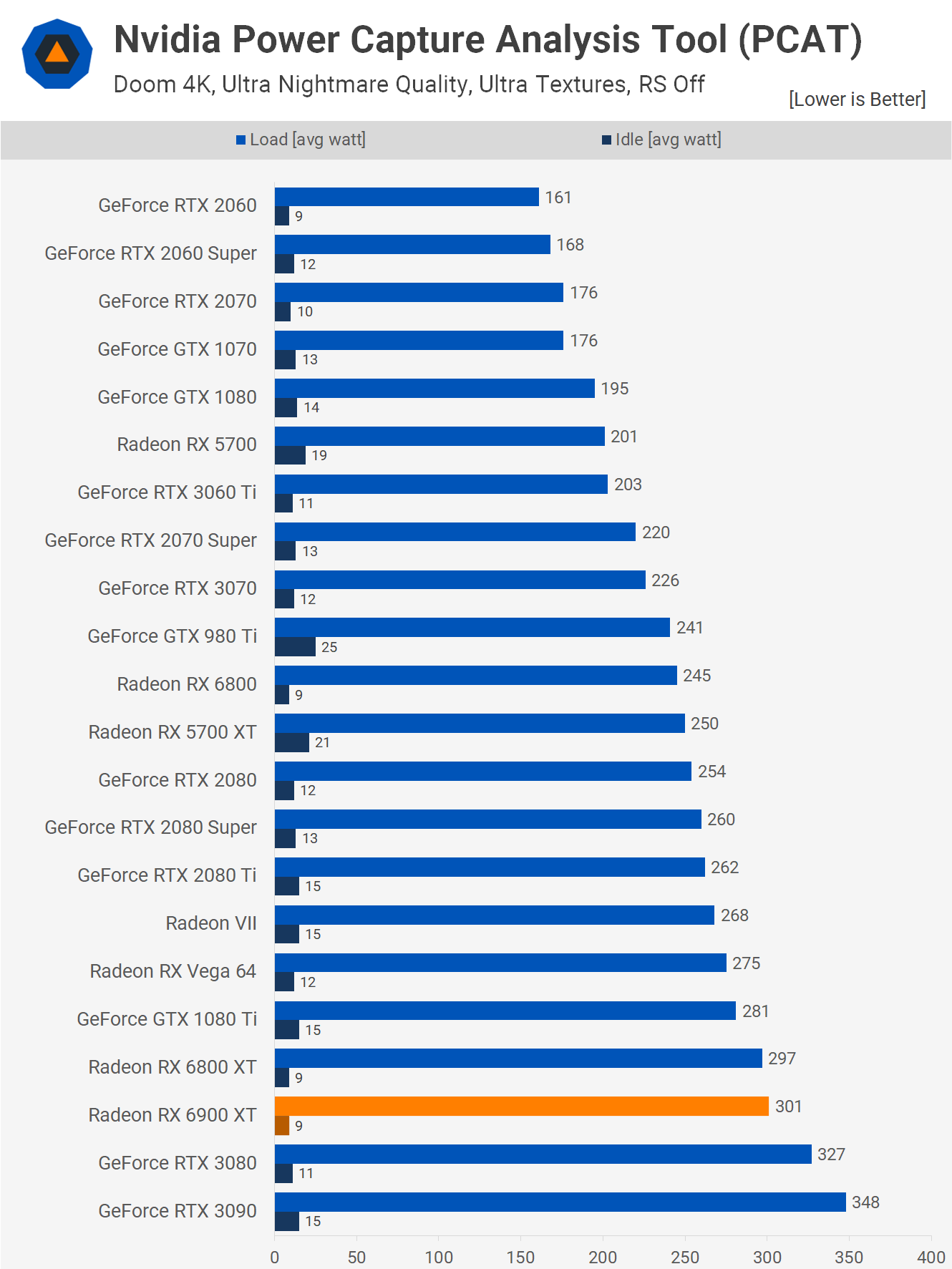

When looking at performance per watt we see that the 6900 XT is only slightly better than the RTX 3090.
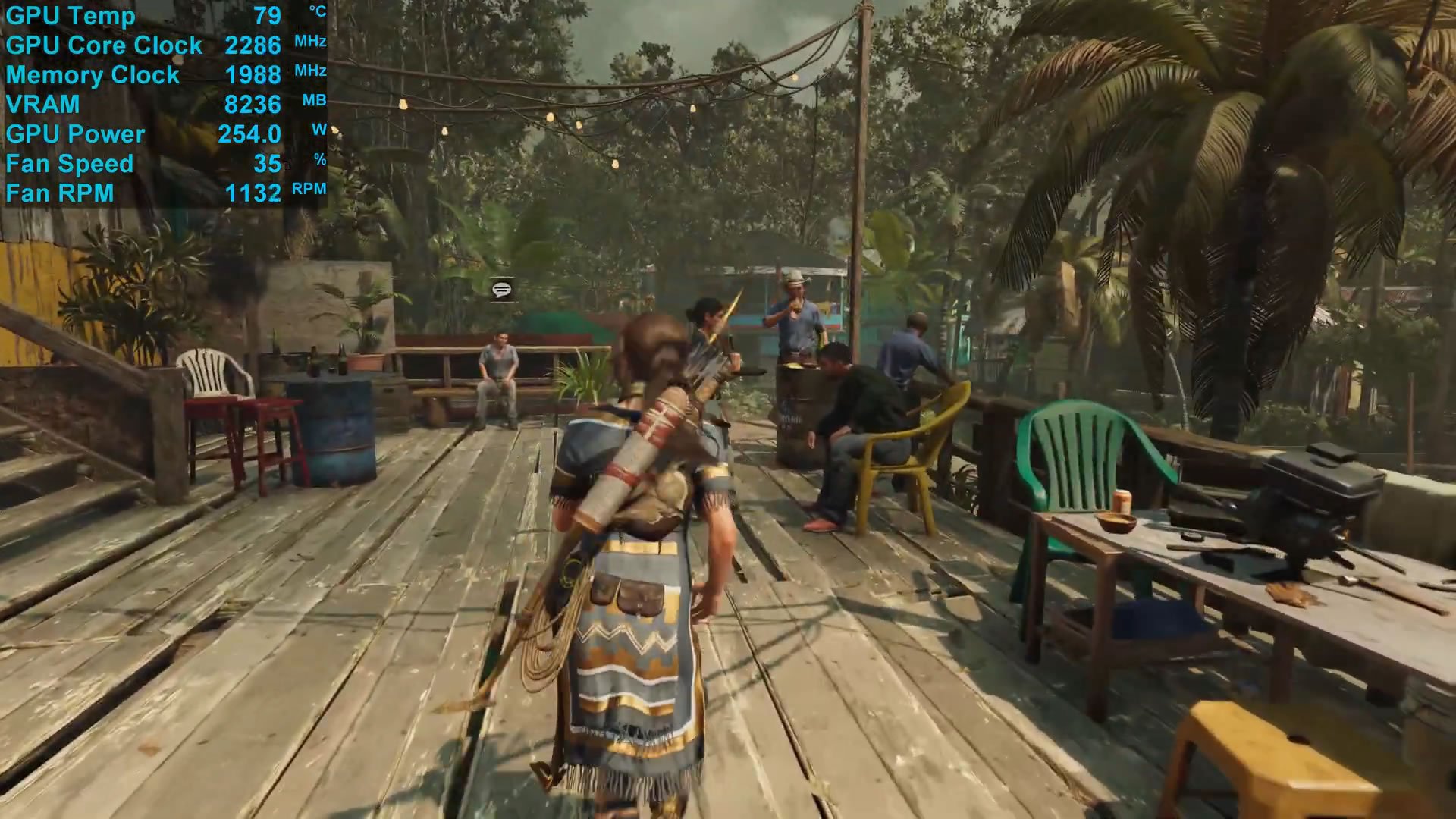
Our AMD 6900 XT reference card ran 5C hotter than the 6800 XT despite using only a few watts more power. However, there is a big difference in fan speed, whereas the 6800 XT card spun its fans at 1500 RPM, the 6900 XT ran at just 1100 RPM which makes the 80C peak temperature quite impressive.
After 30 minutes in Shadow of the Tomb Raider we saw an average clock frequency of 2260 MHz which is around 50 MHz higher than the 6800 XT.
Overclocking
Just like our AMD reference 6800 XT, the 6900 XT graphics card isn't a great overclocker. Pushing it up to 2.7 GHz saw a typical clock frequency in games of around 2550 MHz, and while that's a 13% increase, it only boosted performance in Assassin's Creed Valhalla by 5%, 3% in Shadow of the Tomb Raider and 5% in Watch Dogs Legion.
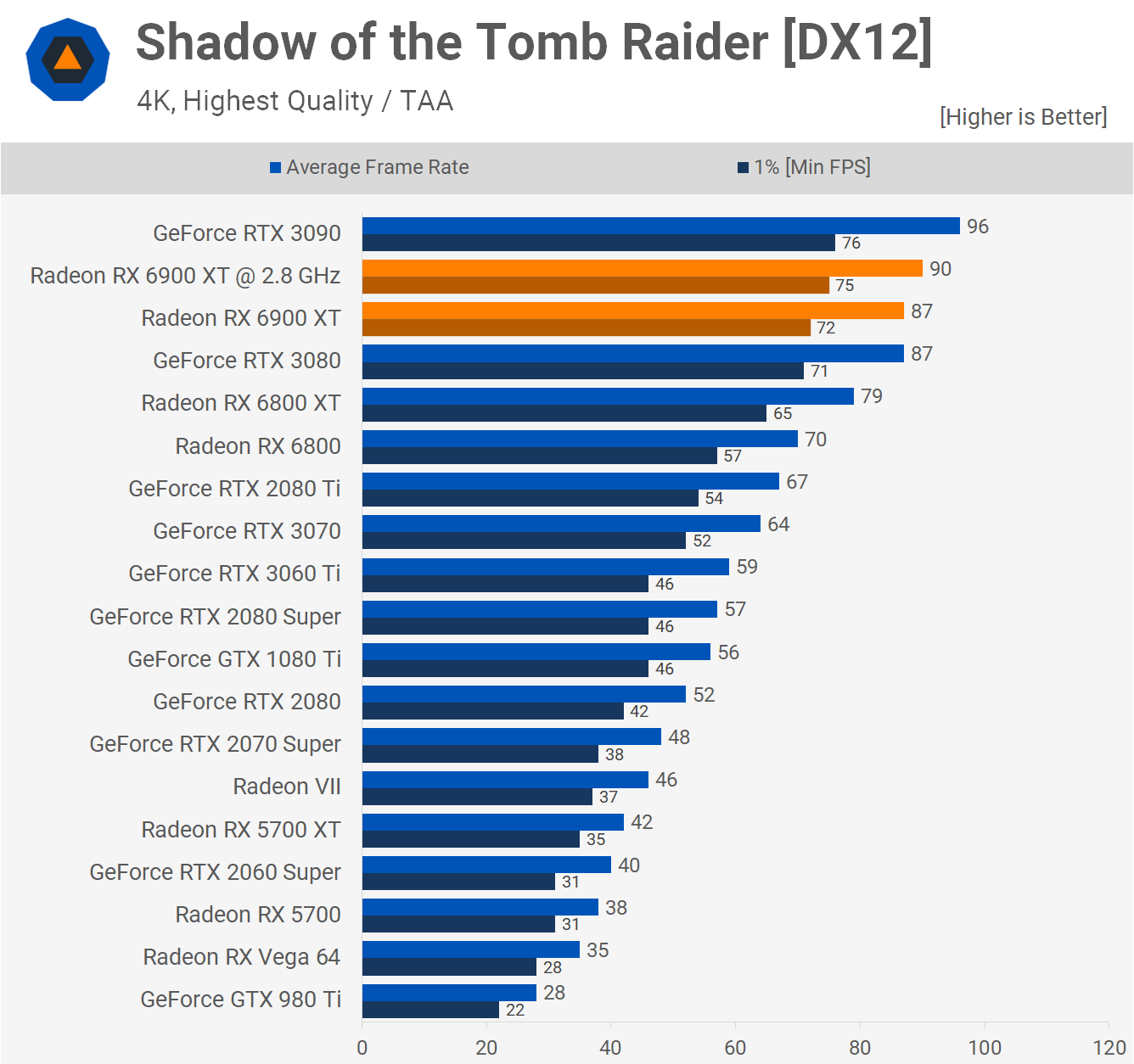

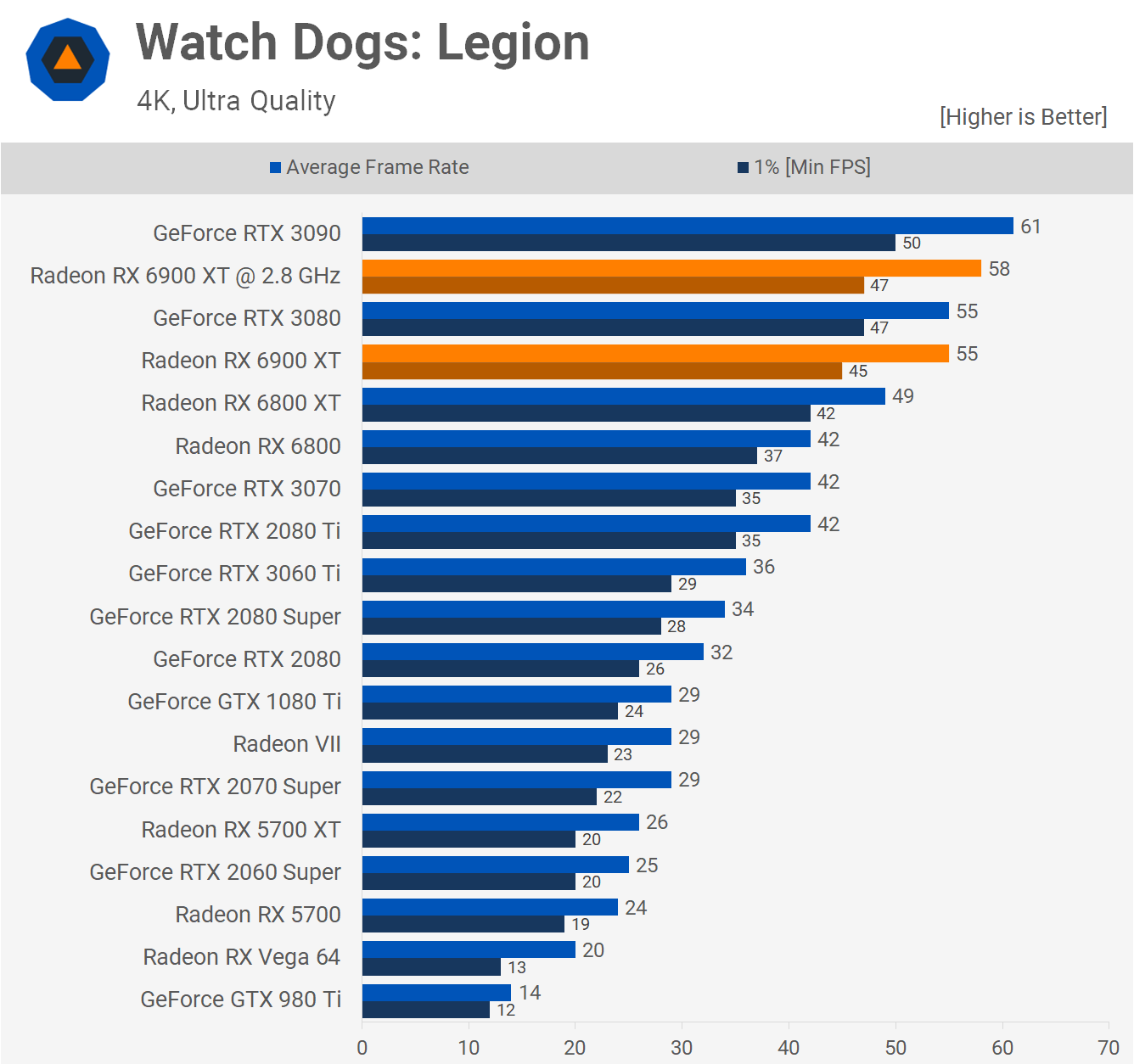
We don't know why the gains are so weak, but this is similar overclocking behavior to what was seen with the reference spec 6800 XT.
Cost Per Frame
The first cost per frame graph focuses on 1080p. Here we're seeing that the 6900 XT comes in 47% more costly per frame when compared to the 6800 XT, so that's kind of terrible. It represents the same kind of value as something like an RTX 2080 Super. It does look great in terms of value when compared to the RTX 3090, but that's just how bad the 3090 is.

Things don't improve much for the 6900 XT at 1440p, where it's 43% more costly per frame when compared to the 6800 XT, despite being 35% better value per frame than the RTX 3090.

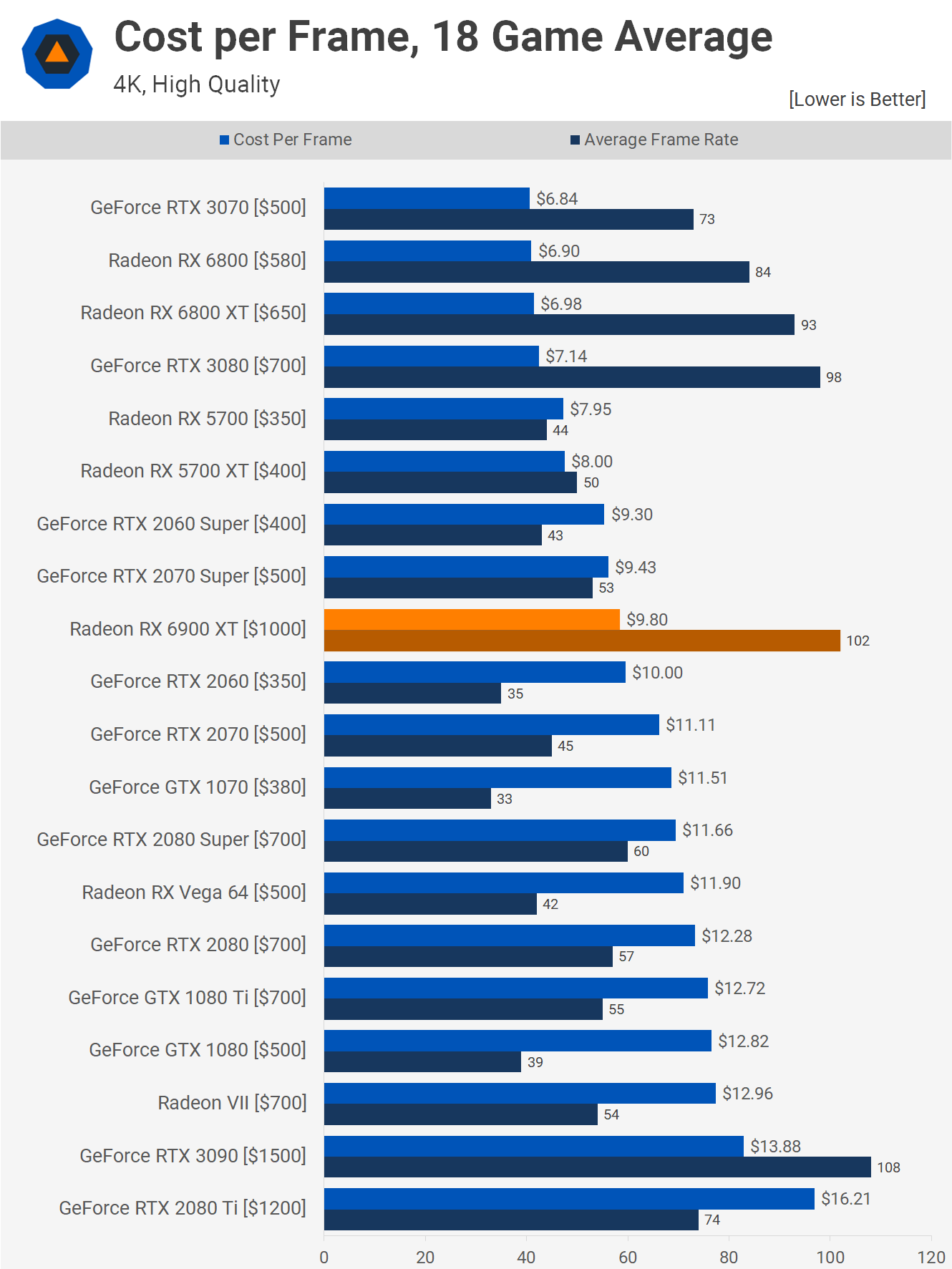
Then at 4K, the 6900 XT is 40% more costly per frame when compared to the 6800 XT, though it's almost 30% better value per frame than the RTX 3090. Still, with the RTX 3080 and 6800 XT offering a similar level of value, it's fair to say the 6900 XT is terrible and the RTX 3090 is horrendous.
Bottom Line
The Radeon RX 6900 XT was never going to make sense, not unlike the GeForce RTX 3090, even though Nvidia's card does get you a lot more VRAM. Essentially, the Radeon RX 6900 XT is the same as a 6800 XT with a few extra cores enabled for a ~5-10% performance boost.
For the 6900 XT to make sense from a value perspective, it shouldn't exceed the $750 price point, assuming you could buy a 6800 XT for $650 which you really can't right now, but we're hoping for that come early 2021. In a world where GPU availability wasn't an issue, there is literally zero reason to buy the 6900 XT. The same is also true for the RTX 3090 over the 3080, unless you required the extra VRAM for some reason. Short of that, there's no reason to spend much more money for the basically the same product.
Now, let's for a moment pretend that both products were reasonably priced, which one should you buy? If you're gaming at 4K or care about ray tracing performance, then we think the RTX 3090 is the better product. It's too early to call the ray tracing battle, but if you're only interested in the games we have available today, then the GeForce GPU is the way to go.
For those gaming at 1440p or lower, the 6900 XT is typically the puncher card, though for the most part it's too close to call. So if they were available at the same price, and it was a reasonable price, we feel the RTX 3090 would be the superior product. However, at $1,500 for the 3090 and $1,000 for the 6900 XT, the Radeon GPU is the better option, assuming you're not heavily focused on ray tracing and we think that might be an issue for AMD with these extreme high-end GPUs.
Typically those with super deep pockets who don't care that they're spending 50% or more for 10% or less performance, probably won't care if it costs $1,000 or $1,500, they'll just go with the outright best product, and as we've said we think that product is the RTX 3090. It offers 50% more VRAM, more mature ray tracing support that's currently yielding far better results, DLSS 2.0 support, and for the most part superior 4K performance.
The Radeon RX 6900 XT is kind of stuck in this strange place where it's really bad value compared to the 6800 XT, good value compared to the RTX 3090, but people looking to invest in this class of GPU won't care about value, they just want the best of the best and in our opinion that isn't the 6900 XT. Who is going to buy the 6900 XT? Die-hard AMD fans and people who desperately want a 6800 XT but can't find one and aren't willing to wait. We're looking at you.
That's going to do it for our Radeon RX 6900 XT review. In short, don't buy it, doing so will simply ensure that the next GPU generation is even more expensive. Then again, we said that about the RTX 3090 and they've been selling like hotcakes, so we guess budget gaming is doomed.
